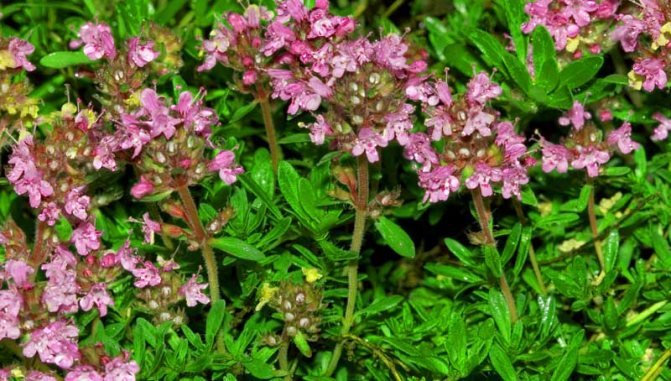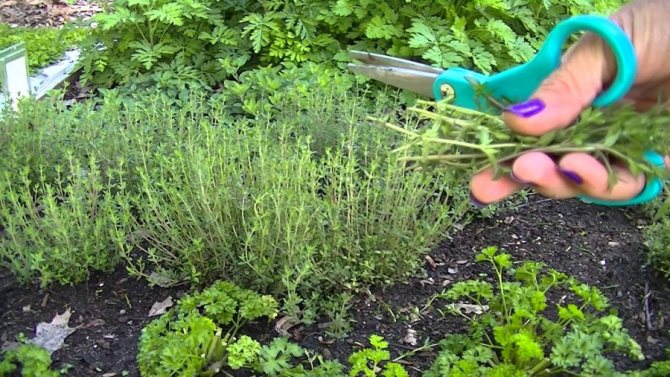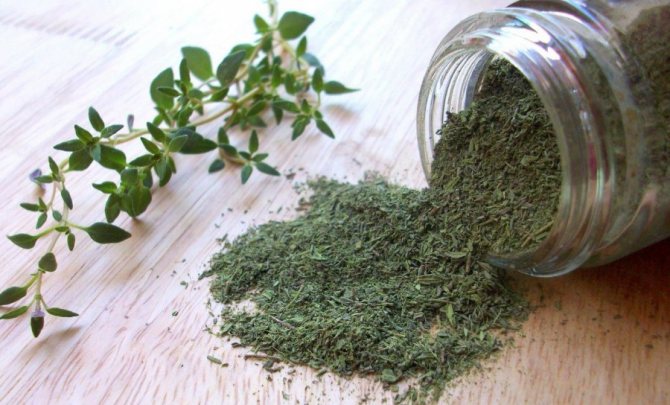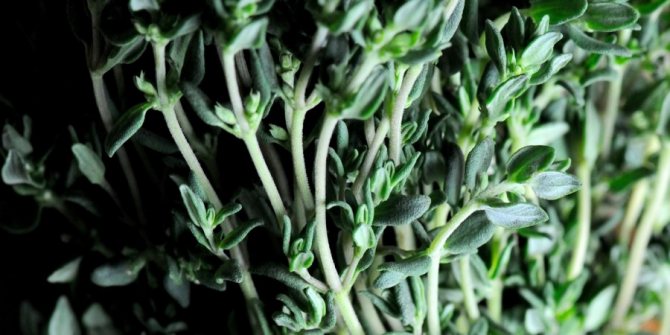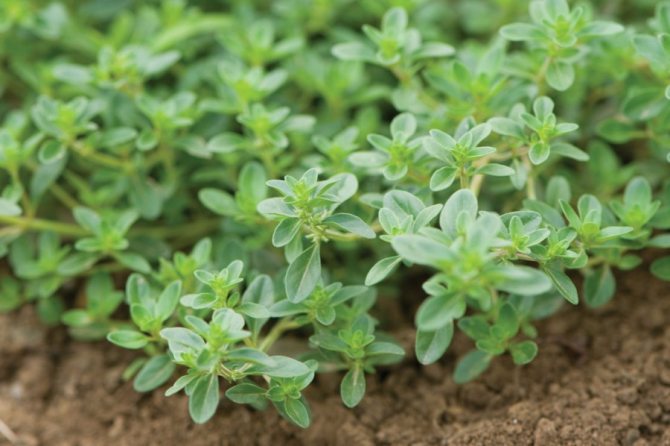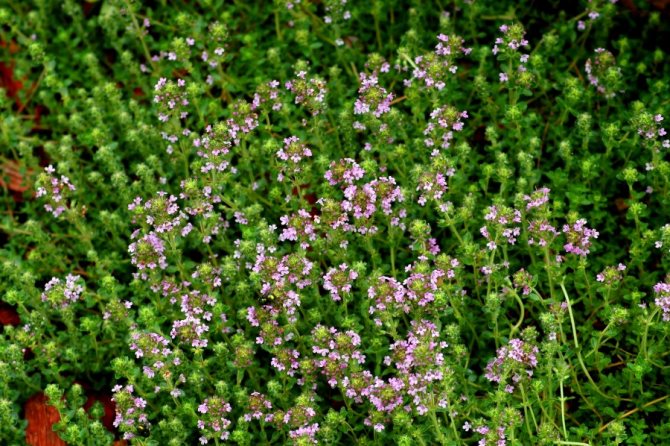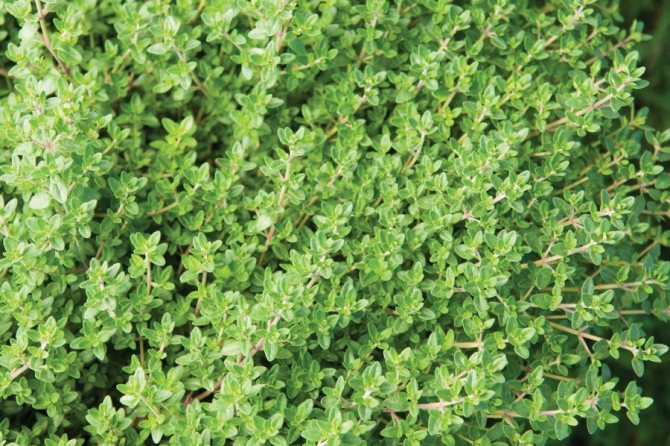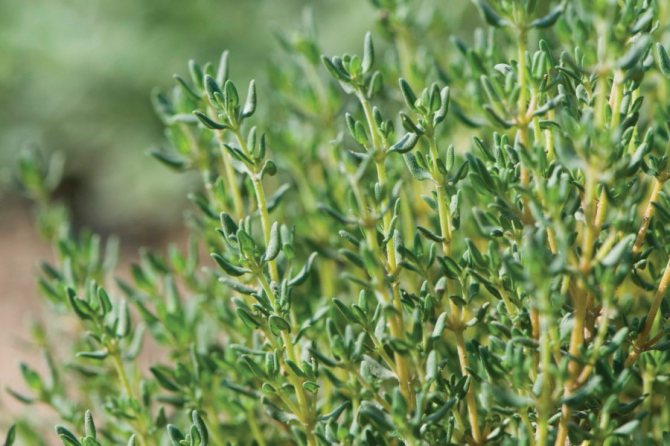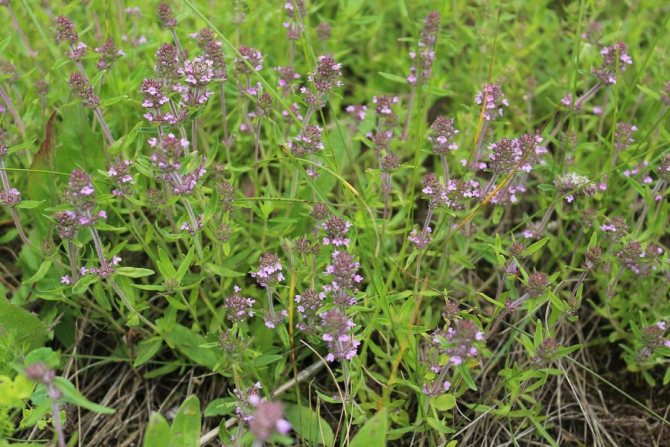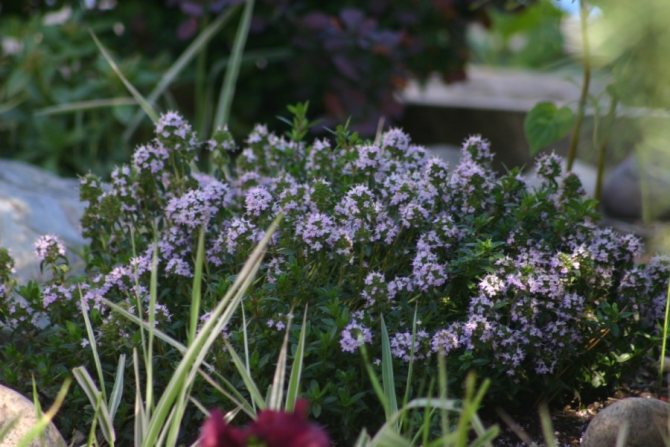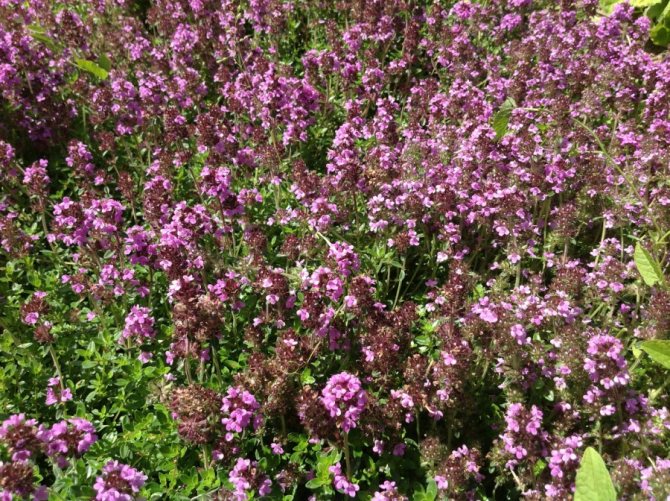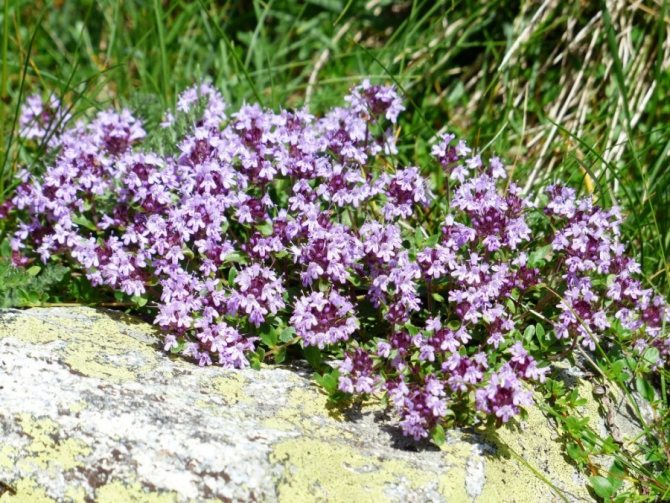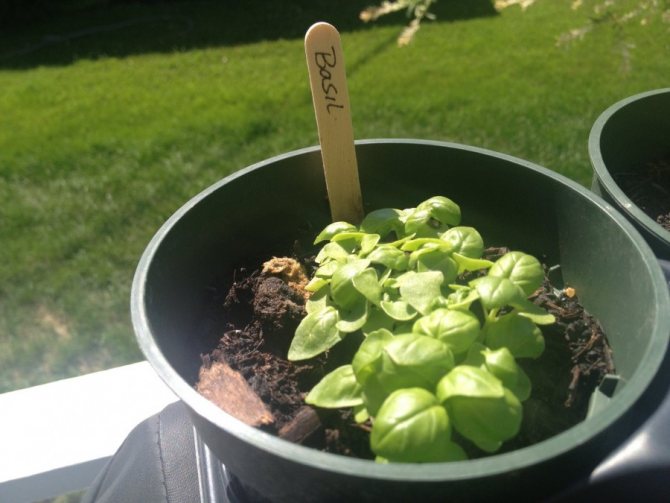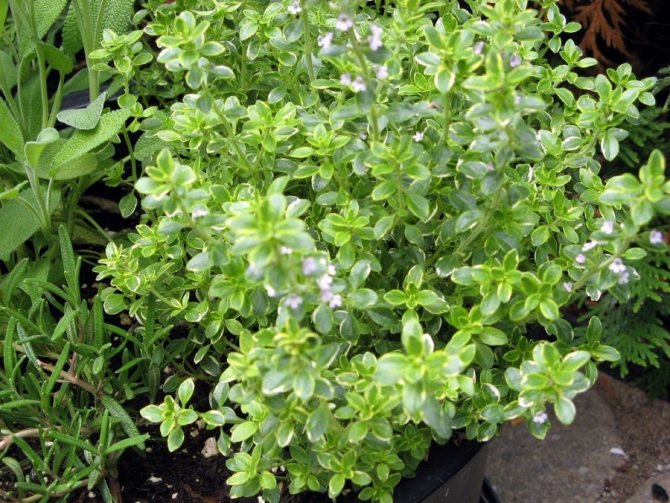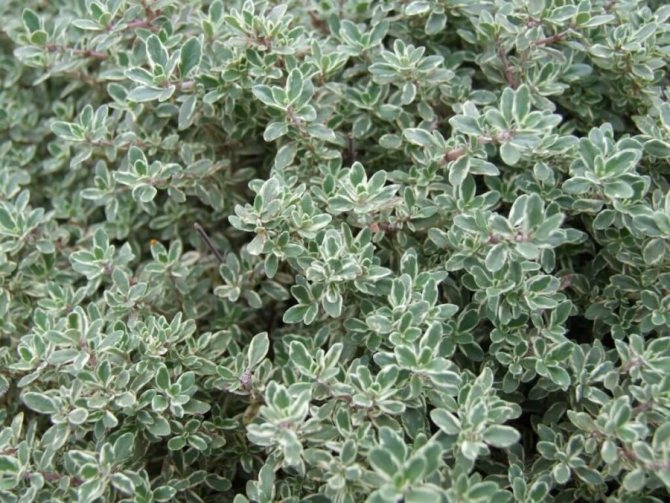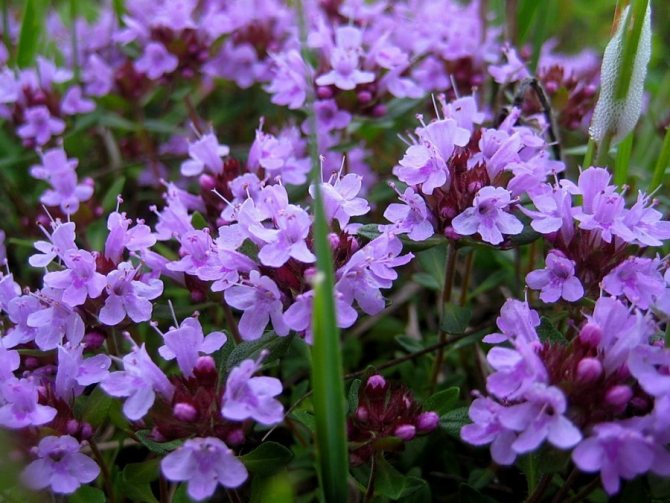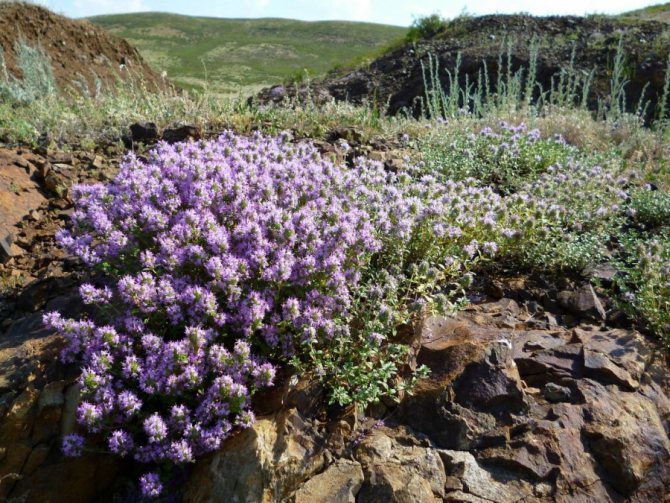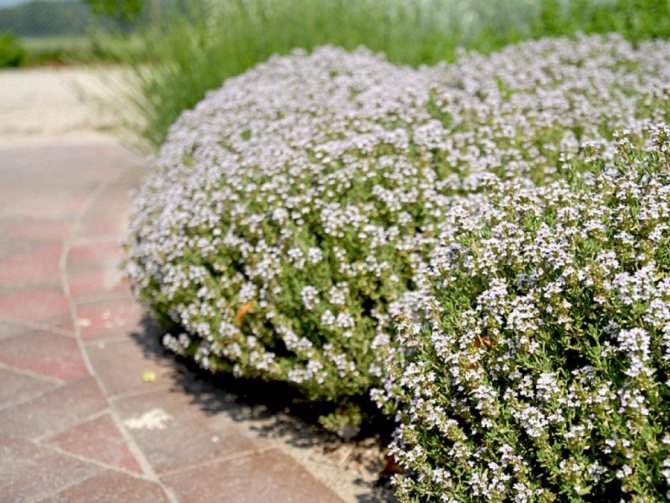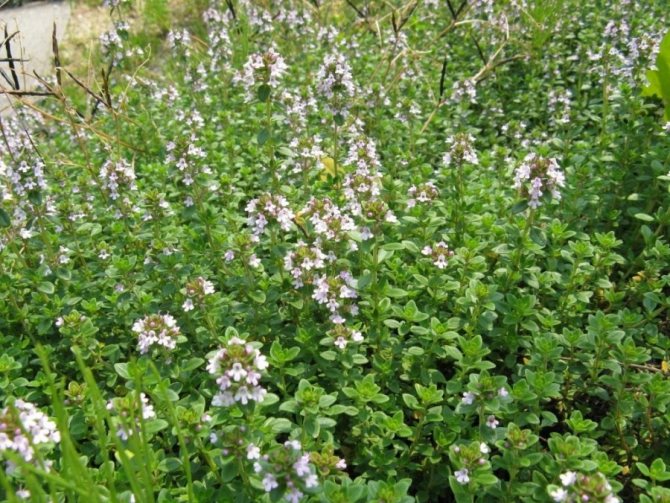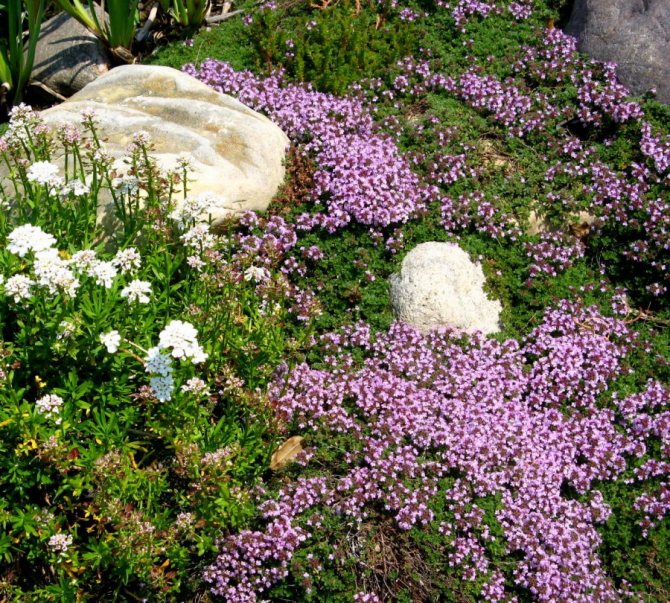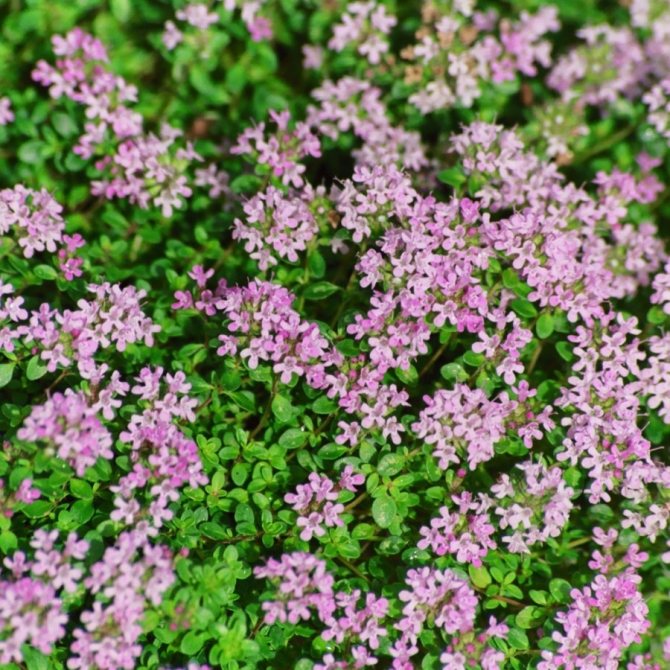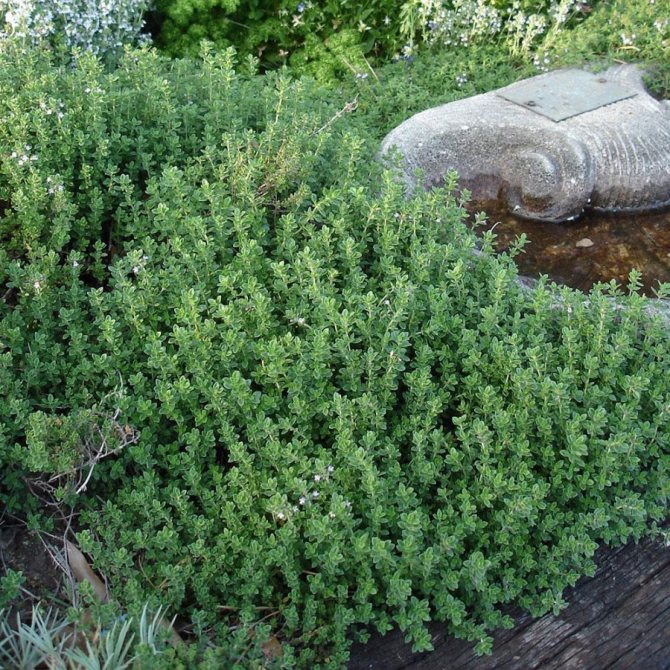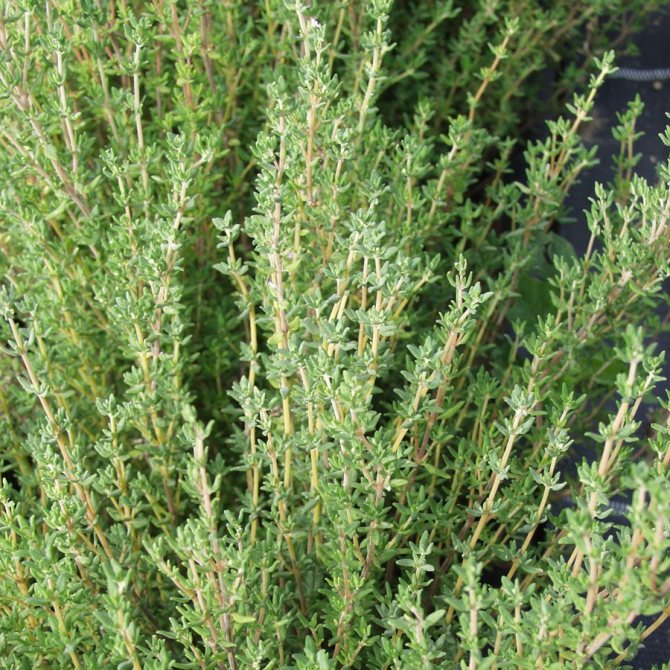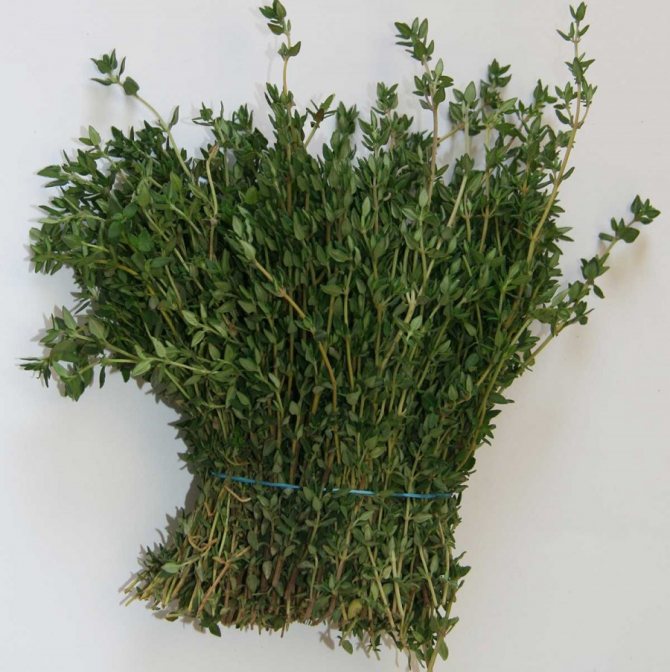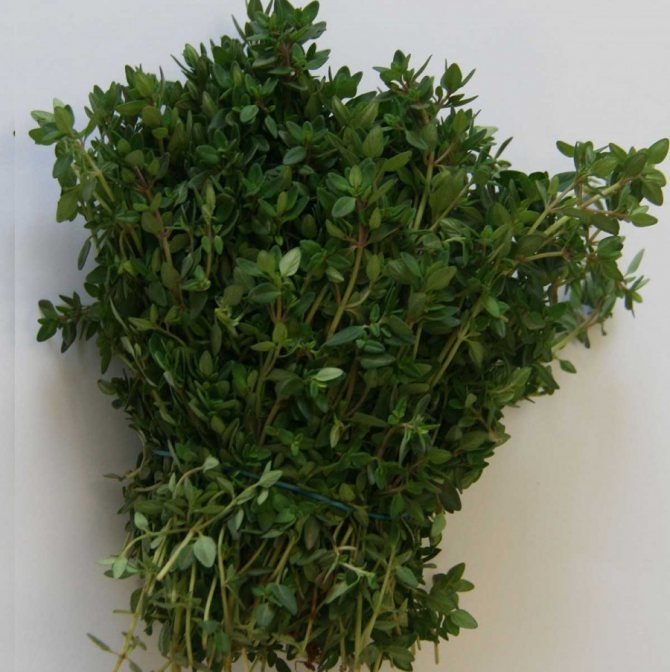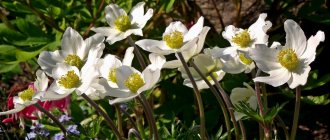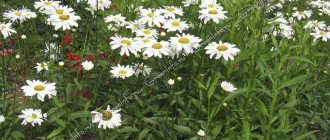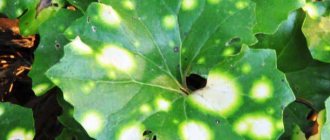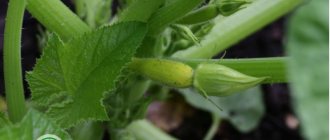A fragrant shrub or thyme shrub (Thymus) is a representative of the largest genus of the Yasnotkovye family. The Russian name "thyme" comes from the Greek word "incense", meaning "fragrant substance." In some cases, thyme and thyme are the same plant, but only when it comes to creeping thyme. Such a plant has many other names among the people: Bogorodskaya grass, lemon scent, fly fist, incense, chebarka, verest. The homeland of such a plant is North Africa, the first mentions of it can be found in the writings of Dioscorides and Theophrastus. This genus includes several hundred species, in nature they can be found on the territory of Greenland and Eurasia. Such a culture is in demand in the perfumery and food industries, as well as in medicine.
Photo of thyme
The plant looks like a wildflower. Small blue, lilac or blue flowers distinguish it favorably against the rest of the grass on the edge. Photo for reference.
Thyme is a folk plant. There are many places where it can be found, so people collect it on their own for the preparation of medicines and culinary additives. Take a look at the photo before going for thyme so as not to be mistaken.
Description of the plant thyme (with photo)
We begin the description of the thyme plant with the fact that it is a perennial evergreen shrub, growing up to 20 cm in height, with a branched stem spreading along the ground and erect flowering branches. Taproot, branched. The stem is erect or ascending, lignified in the lower part, strongly branched, up to 30–40 cm high.
Further on the page is a photo and description of thyme, which allows you to get the most complete information about the culture:
The leaves are small (5–10 mm long), short-petiolate, opposite, with inwardly curved edges, dotted on both sides with dotted essential oil glands, leathery, dark green above, grayish green below, elliptical and whole-edged.
The color of flowers in different species and varieties of thyme can be white, pink, red, lilac. Small flowers are collected in axillary false whorls, forming an intermittent capitate inflorescence on ascending shoots up to 15 cm high. The fruit consists of four nuts enclosed in the remaining calyx.
Nuts 0.7–0.9 mm in diameter, almost round, grayish or brownish brown. The mass of 1000 seeds is 0.3 g.
Look at the thyme plant in the photo, which shows the different stages of its development:
Useful substances in the composition of thyme
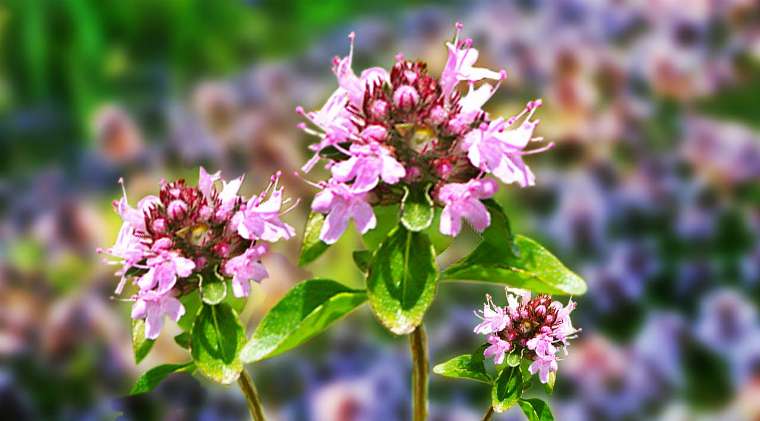
In this section, we decided to consider the chemical composition of thyme in order to understand how you can effectively use it in traditional and regular medicine. Knowing the substances is also useful for those who have intolerances and allergies.
We will highlight only the dominant components, since the full composition will be very large and not informative. The basis of the benefits of thyme lies in acids, and let's start with them.
- Organic acid complex. The plant contains ursolic acid, which increases muscle tone and speeds up metabolism. Also in its composition you can find caffeic acid, it reduces stress and gives a person vigor. Oleanolic acid accelerates the complex cleansing of the body.
- Vitamin C . Also called ascorbic acid, it stimulates the development of immunity, fights against the penetration of viruses into the body.
- Minerals and healthy salts. Normalize the work of the intestines and gastrointestinal tract.
- Timol. It is an element of thyme essential oil, has the strongest antibacterial effect.
- Flavonoids. They strengthen the walls of blood vessels, get rid of blood plaques, and normalize blood pressure.
Due to such a rich composition, the plant is actively used in medicine. In the next section, we will touch on the medicinal properties of this medicinal plant.
Thyme and thyme are one and the same (with photo)
Family Lamb (Lipocytes).
Thyme and thyme are an extensive genus of plants from the Yaroslavl family, numbering several hundred species that grow almost throughout Eurasia, North Africa, North America, the Caucasus, in some regions of western and eastern Siberia, the Canary Islands and even Greenland. The center of their origin is the Mediterranean.
Found in the European part of Russia and Siberia. It grows in elevated areas with dry, well-drained soils, on rocks, in stony steppes, in steppe meadows.
There are several versions of the origin of the generic name "thymus". One by one, it comes from the word "thymos", which means "strength", "courage". According to another version, as Karl Linnaeus points out in his "Philosophy of Botany", this name was given by the ancient Greeks for the healing effect of the plant - "breath of life", "spirit".
According to the third version, the generic name is associated with the word "thyo" - "to make sacrifices", since creeping thyme is the most ancient cult plant, and many peoples had a custom of burning it in temples and on altars to get fragrant smoke (incense).
In Russia, creeping thyme is often called the Bogorodskaya or theotokos grass. This is due to the custom on the day of the Assumption of the Virgin to decorate her icons with fragrant bunches of thyme.
Almost all thyme are fragrant low semi-shrubs, often with recumbent woody stems and herbaceous flowering shoots. The most famous are two of them - common thyme with erect stems and creeping thyme, or Bogorodskaya grass.
The fact that thyme and thyme are the same can be seen in the photo, which shows plant samples in different phases of vegetative development:
The healing properties of thyme
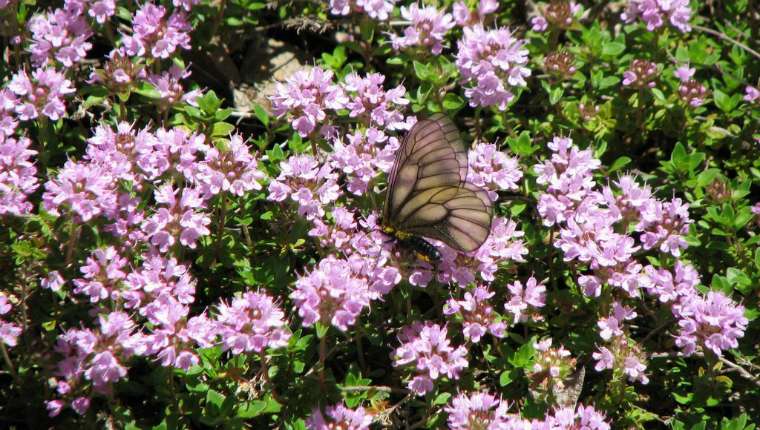

The rich composition in itself has little to attract the average lover of natural medicine. It is much more important how these components accumulate and help a person cope with ailments. Here we will touch upon the usefulness of thyme in more detail.
Note that thyme is used not only in medicine, the absence of disease symptoms does not mean that you cannot make tea with thyme, for example, or add it to a confectionery masterpiece.
- Reduces pain. A decoction of thyme is advised for those who do not want to drink pills for headaches or stomach pains.
- Cleans the stomach of toxins. Tea with thyme is useful for people who periodically consume alcoholic beverages and tobacco.
- Fights viruses and light strains of bacteria. This is due to organic acids, including vitamin C.
- Expectorant properties. Thyme, along with sage, is great for sore throats.
- Calms the nerves. In stressful situations, it is useful to drink tea with thyme, it restores sobriety, normalizes the functions of the central nervous system, and gives strength to implement plans.
Each person on this list will find something important and necessary for themselves. But it is worth highlighting the unique properties of thyme to treat narrowly focused male, female and children's diseases.
- For men . Many middle-aged men suffer from sexual weakness or dysfunction. Thyme normalizes blood flow and blood flow to the genitals.The course is not quick, you will need to replace classic black tea with tea with natural thyme within 2-3 months.
- For women . Women who experience severe menstrual pain should also pay attention to thyme or thyme essential oil. The plant, as noted earlier, actively affects the blood and nervous system.
- For kids . Little children under 7 years old do not sleep well, the point is in physical growth and hormone activity. Tea with thyme before bedtime will give your child a calm and healthy sleep.
The medicinal properties of thyme will reveal themselves even better if you turn to the recipes of the national health resort, which we will talk about right now, fix a few recipes for yourself, they will come in handy.
Landing
Loose soil is a favorable environment for planting and growing thyme. Also, abundant sunbathing has a positive effect on growth, so it is necessary to plant thyme in a place accessible to them.
It is important to dig up a plot in the fall, with special zeal, so that the plant can get along in a new place for it. To this, it is necessary to add fertilizers of an organic basis, it can be both compost and manure.
Once again, the soil will need to be dug up in the spring, when the temperature outside will be more than 13 degrees. The next step is planting seeds.
note: after planting thyme, it is worth sprinkling it a little, with sand taken from the river bank. Thus, the influx of elements important for growth to the young plant is ensured, and excess moisture is not formed on the surface.
The shoots should rise and grow a little, after which they can be thinned out, make the distance between the seedlings about 25-30 cm.
It is interesting that it is possible to plant seeds even in winter, the seedlings will be an indispensable assistant in this matter. Thyme is planted in boxes prepared in advance and carried out regular, moderate watering.
Thanks to the glass under which the plant is located, a greenhouse effect is created, which accelerates growth. After 3-4 weeks, it is necessary to take out the seedlings, for hardening, outside. And after about 2 weeks, you can plant the thyme in the place where the plant will grow for its entire long life.
The use of thyme in traditional medicine.
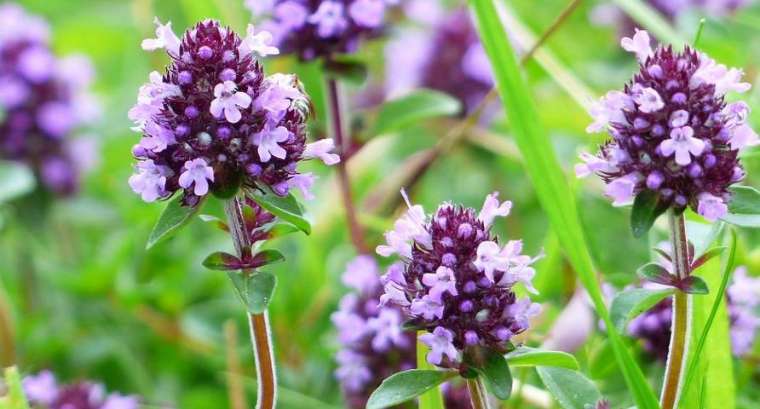

Folk remedies differ from regular industrial preparations in that their formulation was developed not by pharmaceutical scientists, but by ordinary people who once knew everything about herbs.
When there were no pharmacies and clinics, people were forced to look for ways to get rid of diseases. And they found them. For many centuries, methods of treatment have been passed from mouth to mouth, reach us and end up on the Internet.
- For colds. Organic acids play the role of antibiotics and antiseptics, it cope with bacteria, suppress viral activity and the spread of fungi.
- For constipation / diarrhea. Thyme regulates the digestive tract. The decoction from the plant does not strengthen or thin the stool, it allows the body to independently come to normal functioning.
- For the treatment of headaches. Not all of us prefer to take pills. Tea with thyme regulates blood pressure, relieves a person from headaches, and not once, but for a long time.
- Against insomnia. Thyme, as mentioned earlier, soothes the nervous system and allows you to fall asleep even with severe stress, you can sometimes drink during pregnancy.
- To maintain immunity. There is nothing more important to our health than immunity. If it is not there, then diseases will pour in, as if from a cornucopia. Thyme with vitamin C can support it.
One can argue endlessly about the effectiveness of certain methods, but it was folk remedies that allowed humanity to survive in a time when they were dying from the simplest infections. Let's take a look at how our ancestors used thyme and follow their example. It won't get any worse.
Reproduction
Thyme is capable of multiplying in three ways, provided that it is in the open field:
- Seminal. In autumn, material suitable for planting is collected and dried until spring, after which it is sown and covered with film. They are planted both in spring and autumn.
- By cutting a cutting... They are selected from the strongest when pruning in spring or autumn. As a practical matter, the seedling forming a new bush is already matured.
- By dividing in half... Attention this method can be painful for the plant. It is necessary to dig up the bush completely and divide it into two halves with special care. If in the process you damage the root system, then the new shoot can get sick or worse, die.
Traditional recipes with thyme
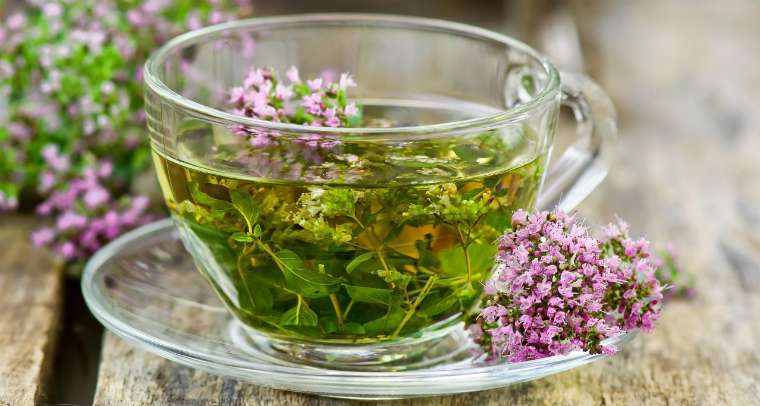

The recipes that we provide you in the selections have proven to be simple and healthy. Of course, there are many more of them, each individual grandmother has a recipe for a decoction of thyme, which no one else knows about.
Folk recipes change over the years, their preparation is simplified, some components are replaced by others. Traditional medicine is a living organism that does not give right and wrong answers. Everything is checked by trial and error, everyone will find their own recipe for themselves.
Thyme tea
Making herbal teas is a simple and straightforward way to familiarize yourself with medicinal drinks. This is the place to start if you are new to herbalism.
- Boil half a liter of water. It is better to take filtered water, not from the tap.
- Add 2-3 tablespoons of chopped dried thyme to it. This is slightly more than black tea would require, but tea has a slightly stronger flavor concentration.
- Leave to steep for 6-10 minutes. This time will be enough for the thyme to give all the nutrients in the composition to the water.
- Drink as if it were tea. You can drink with sugar, with sweets, with anything. But remember that excess sugar damages your metabolism.
Thyme care
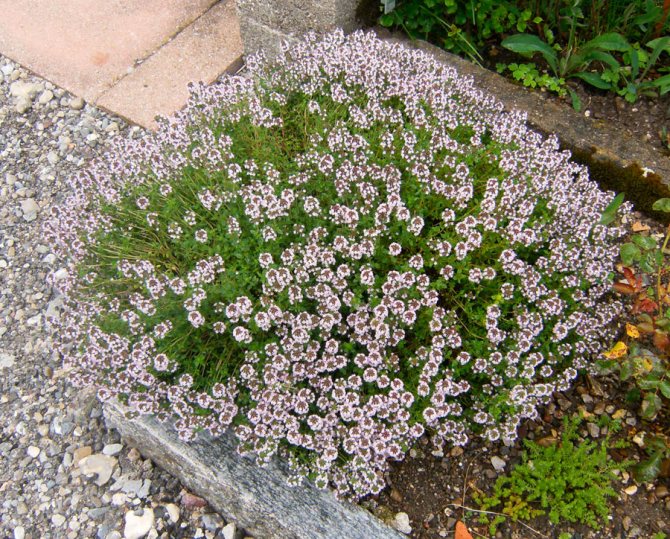

So that no stagnation of water is observed in the root system of the bushes, and no crust appears on the surface of the soil, it must be regularly loosened. It is necessary to weed the bed in a timely manner, pulling out only the weeds that have appeared. To reduce the number of weeding and loosening, the surface of the site must be covered with a layer of mulch (compost). You also need to regularly prune the bushes, this is done in early spring or after the thyme has faded. It is necessary to shorten the stems by 2/3 before their lignification begins. The pruning of bushes must be carried out in order for them to become compact and denser.
How to water
Such a culture reacts extremely negatively to stagnation of liquid in the roots, but it is drought-resistant. Because of this, watering thyme should only be done when absolutely necessary. When the bushes bloom and young stems begin to grow, they should be watered a little more often. If it rains regularly in the summer, then there is no need to water the bushes at all.
Fertilizer


Thyme does not particularly need additional feeding, especially if all the necessary fertilizers were introduced into the soil before planting the thyme. Only if the soil in the bed is very poor, the plants will need feeding, for this the surface of the bed should be mulched with rotted compost or horn flour can be added to it.
What can be grown after thyme
Since thyme does not need a large amount of nutrients and after it the soil does not deplete, as, for example, after potatoes, cabbage or celery, then after it any plants can be cultivated on the site, but they should not be members of the Lamiaceae family.
Thyme-based medicines
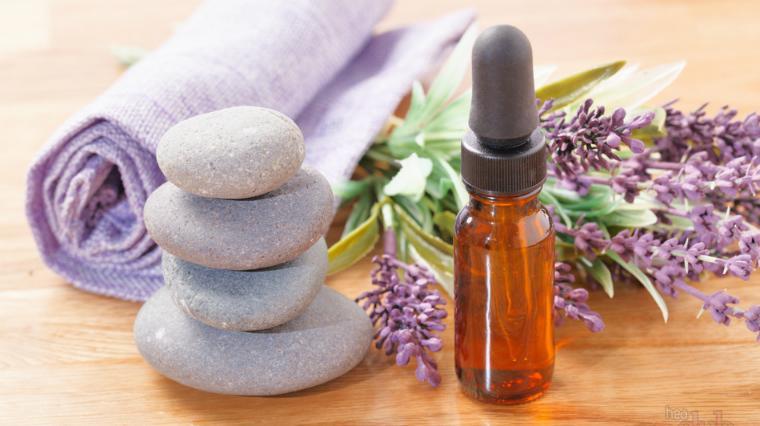

Pharmaceutical companies keep an eye on good natural herbs. Therefore, in pharmacies you will find a lot of medicines for the treatment of diseases, and they will contain thyme or the essential oil of the plant.
Chemical manipulations cannot create a complete analogue of a natural plant, so pharmacists do not try to reinvent the wheel, but use what nature has invented.
- Codelac broncho with thyme. A drug created to combat dry cough. Expectoration occurs due to the essential oil of thyme.
- Pertussin. A popular cough syrup with an expectorant effect. Expectoration occurs precisely due to the thyme.
- Licorice syrup with thyme (Kashlestopy). Another remedy for coughs and diseases of the upper respiratory tract, the main active ingredient of which is thyme.
- Thyme essential oil. The strongest concentrate that can be used to treat any respiratory ailment. Application: inhalation, compresses, tea additive.
- Dry herb of thyme. If you do not have the ability or desire to collect the herb yourself, you can buy dry thyme herb at the pharmacy. It is simply thyme, commercially dried without added chemicals. It is no worse or better than what you can assemble yourself.
Industrial medicine focuses on the treatment of cough, but practically ignores other uses. Perhaps scientists have not yet come to objective conclusions about the treatment of the gastrointestinal tract, nerves or erectile dysfunction.
Thyme pests and diseases
Thyme pests
Such a culture is highly resistant to various diseases and harmful insects, since it contains essential oil. However, if you do not follow the agrotechnical rules of this culture, then sandy slugs, meadow moths, aphids and weevils can settle on the bushes.
Meadow moth


Caterpillars of the meadow moth gnaw the seamy surface of the leaf plates, while they braid them with cobwebs. They also injure flowers and stems. For the purpose of prevention, you need to ensure that there is no weed on the site, and in the autumn they dig it. To get rid of such a pest, the bushes are sprayed with a solution of Decis.
Sandy slow
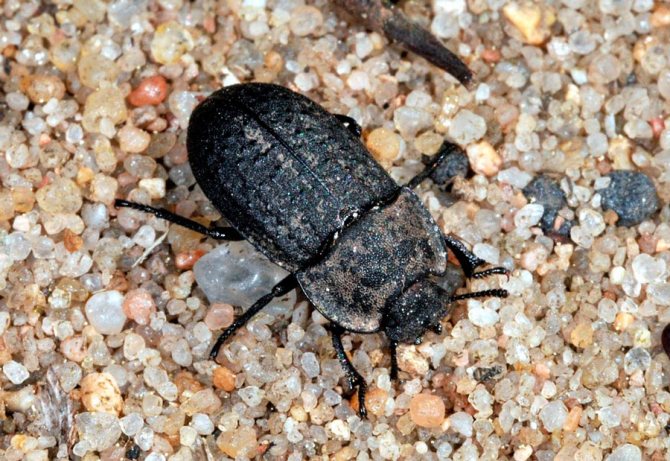

Sandy slug is a black beetle that reaches 0.7–1 centimeters in length; it affects the aerial parts of the bush. To get rid of such a harmful insect, you will need baits that are poisoned with pesticides.
Aphid


Aphids are a sucking insect, they suck sap from young stems and leaf plates, biting through them. To destroy them, drugs such as Antitlin and Biotlin are used.
Weevil
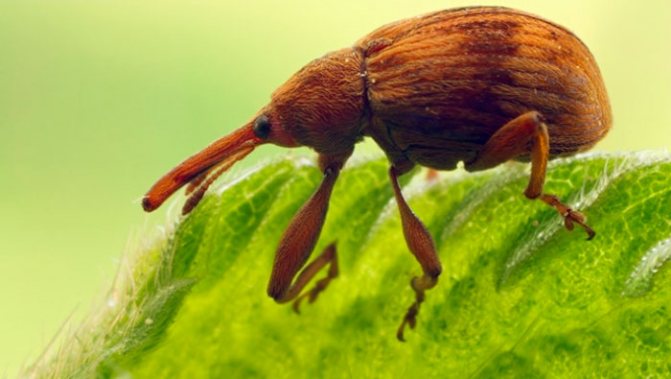

Weevils injure flowers, laying larvae in buds. To get rid of them, the bushes are sprayed with a solution of Fitoverm, which does not harm humans.
Diseases
If you take care of such a culture incorrectly, or rather, water the bushes too abundantly, this can cause the development of a fungal disease. To cure the affected bush, it is treated with a fungicidal preparation: Ridomil, Horus, Fundazol, Topaz or another agent of similar action. But it is better to try to make sure that the plants do not get sick than to treat them for a long time. And for this it is enough to properly water the thyme.
Correct harvesting of thyme


If you decide to independently prepare yourself a few bunches of thyme for the winter, then you will be interested to know how to do this effectively, how not to spoil the entire harvest. We will step by step analyze the procedure for collecting, drying and storing thyme.
If you are worried that something might not work out, then you are wrong. It is enough to follow the elementary instructions, not to come up with something that has already been invented. Compliance with the algorithm is a guarantee of success.
Collection of thyme
In fact, collecting thyme is not as difficult as not destroying it. Do not cut the plant to the root, this will disrupt its growth and assimilation. Take care of nature, and she will reciprocate you.
- Thyme is harvested from mid-May to late August, during the flowering period.
- The more flowers on the plant, the more fragrant and healthier the thyme.
- If bees are flying around, then the collection time is perfect, thyme is a honey plant.
- Thyme should be harvested in the afternoon, when all the dew has subsided.
Here is a simple instruction for collecting a plant. It is not difficult to comply with it, there should be no problems. It remains only to find a clearing, where there will be a lot of it, and you can choose the best grass.
Drying thyme
You can also dry the thyme without any problems. There are only three recommendations that must be strictly followed.
- Do not dry in the sun, properties are lost.
- Stir the thyme while drying. This way you will not get rotten herbs.
- Drying should be carried out in a dry room without condensation Rotting is the biggest drying problem.
If you follow these three postulates, you will end up with a fragrant herb, from which you will prepare teas, infusions and decoctions.
Storing thyme
Thyme should be stored according to the same principles as dried. It means. That after proper drying it can be reassembled and left in place until needed.
- Thyme is best stored in bunches, so the structure will not break.
- Store in places where no one can crush it. Dry leaves can turn to dust if handled roughly.
- Try to use everything that you have prepared for a year. Fresh tea from the plant is better than one-year-old.
The finished thyme has a delicious aroma that intensifies when rubbed. It's time to talk about sad things, about contraindications.
Planting thyme outdoors


What time to plant
Planting thyme seedlings in open soil should be carried out from mid to late May. The area suitable for planting should be well lit. It can also be grown in a shaded area, but such bushes do not develop well and stretch a lot. The soil should be well-drained, nutritious, light, alkaline or neutral. If grown in clay and damp soil, the bushes may rot, therefore, it may be necessary to organize good drainage.
Preparation of the site for planting should be done in the autumn. To begin with, you need to remove all plant residues from it, then dig it up, while rotted manure or compost, as well as potassium-phosphorus fertilizer, should be added to the soil. In spring, before planting, the site must be loosened, and the soil is spilled with a solution of urea (20 grams per 1 liter of water). When planting bushes, a distance of 20 to 25 centimeters should be observed between them, while the row spacing should be from 0.4 to 0.5 m.
Contraindications to the use of thyme


Thyme does not have as many contraindications as industrial pharmaceutical preparations. However, there are strict conditions under which thyme should not be eaten or treated with it. Read this list carefully, otherwise this wonderful herb will leave you only unpleasant impressions.
Medicines work differently for each person. In any case, monitor your body condition after consuming thyme. If you start to feel itchy skin, fever, or chills, then this plant is not suitable for you.
- Do not use the herb for kidney and liver failure. Thyme has a mild diuretic effect, removes moisture from the body, and can provoke salt deposition.
- With diseases of the thyroid gland.
- With heart disease. Thyme actively affects the blood, liquefies plaques; if the heart does not work correctly, such an effect can lead to arrhythmias and stroke.
- With high acidity of the gallbladder and stomach. The acids in the plant will enhance the effect.
Types and varieties
Bogorodskaya grass is a semi-shrub, because it tends to spread over the ground, thereby turning into a fragrant green carpet.
Common varieties:
- Semi-shrub up to 10 cm high with lilac flowers - variety Kolkhida.
- A dense carpet of pink leaves framed by a yellow stripe - Donna Vale.
- The herb with the exquisite name of the Silver Queen grows in a rare carpet, 20 cm high. The shoots are tightly placed to each other, when blooming, they have a lavender hue.
Other varieties:
- Common thyme. Shoots have a color close to white or purple. A light fluff is located on the back of the leaves. The height of the bush is 10 cm.
- Lemon-scented thyme. It is called so because of the unobtrusive scent of lemon, which is spread by yellowish leaves. It is found in several forms, here are the most famous:
- Aurea leaves have a bright yellow color.
- The shoots of Bertram Anderson are painted in a green shade with yellow specks.
- Our country is rich in such varieties:
- Early Minor thyme - it has small fluffy leaves.
- Pseudolanuginosus (Pseudolanuginosus) is a profusely flowering plant with pointed green leaves. Used in the creation of rockeries, rock gardens, as part of other landscape compositions.
Description of thyme
Early thyme or thyme is a small perennial shrub. The plant grows up to 30 cm in height. The size and height of the shrub depends on the conditions where it grows.
How to recognize thyme:
- The barrel is deep red;
- The twigs are thin, they have small oval leaves;
- The leaves have thin white villi;
- The base of the leaf is light gray, the top is dark green or bluish;
- The top of the stem is covered with small lilac-pink flowers;
- The fruit is presented in the form of a box, which contains 4 small spherical black nuts;
- Thyme aroma is spicy with a little bitterness, pleasant, spreads at least 3 m. The aroma is strong due to the high concentration of essential oils.
Knowing what wild thyme looks like, you can stock up on medicinal herbs for the future. Very often inexperienced herbalists confuse thyme and oregano. They are similar in appearance and aroma, but the healing effects are different, each has individual contraindications. Therefore, it is important to learn to distinguish between plants from each other. The difference lies in the color and shape of the flowers and leaves.
A useful plant grows almost throughout the entire territory of the Russian Federation, it is unpretentious to soil and weather conditions. In Europe, USA, Canada, it is specially propagated.
Mountain thyme is a good honey plant. It is used in cooking, steamed delicious and healthy tea, added to sauces. Thyme has found wide application in folk medicine; the herb has been used for a long time.
Description and healing properties
"Courageous" is the translation of the word thyme from the Latin language. This plant belongs to the Yasnotkovy family.
Purple flowers, with small elongated leaves, grow on a dwarf shrub, reaching up to 15 cm in height. Thyme is often found along roadsides, near rocks, or in clearings open to the sun.
Thyme herb has medicinal properties. Scientists have found an essential oil in it, which is produced from the green part of the bush, the one that is closer to the ground. The main components of the oil are thymol, oleic acid and vitamins.
Due to these components, the shrub can be used to cleanse the blood, improve digestion, as an antipyretic and sedative.
It is interesting: thyme is used as a stuffing for a pillow, because according to legends it gave longevity and health to a sleeping person.
To raise the tone, gain strength, the ancient Greeks took a bath with thyme, and the Egyptians used it as a perfume, as well as when embalming the dead.
Where can you collect thyme
On the territory of Russia, most of all thyme grows in the Crimea, Tatarstan, the Krasnodar region, the Caucasus and the Urals. You can find a fragrant plant in the Moscow region, Siberia, Leningrad or Nizhny Novgorod regions. Thyme is an unpretentious crop and can be found in almost all open sunny areas. Where it grows:
- At the edge of the forest;
- In meadows and fields;
- In the steppe area;
- In dry forests;
- Near the foot of the mountains;
- In the pine sands;
- On open sunny slopes.
Collect the plant twice over the summer. The first harvest is recommended during the flowering period (July), the second time, when fruit ovaries appear (third decade of August).
On a note. The most favorable time for collection is the first period when the plant blooms. At this time, thyme has the strongest healing properties.
On a large plantation, collecting is carried out with special equipment (mower), for self-collection it is necessary to prepare garden shears, pruning shears.
The branches are cut along with the flowers, 15 cm recede from the surface of the ground. If you cut the plant at the root or pull it from the ground, then there will be no more harvest on this plantation.
Thyme is a plant from the Red Book. The growing area is sharply reduced every year, but it is still harvested for personal use, most often dried thyme is used to treat diseases.
Care and feeding
The most important procedure to be done first after planting is to pinch the end of the stem. This is done specifically so that the shoot forms a sprawling and beautiful bush.
Thyme is a perennial crop and, like everything else, needs pruning, which is carried out every season. When flowering stops, this happens in the fall, it is important to shorten the shrub. Changes from this procedure will be visible in the next season. The plant will acquire a compacted form.
The uprooting of weeds and frequent weeding is necessary for the Bogorodskaya grass, because foreign plants take up most of the nutrients.
Watering should be done about twice a week, provided the weather is not too dry. If the air temperature is not very hot, then this procedure can be carried out less often.
It's important to know: Before winter, cover the shoots with peat or leaves that have already fallen to the ground.
It is interesting that the introduction of wood ash into the open ground will have a better effect on the seedling than fresh manure. This option will reduce the concentration of acids in the soil.
Urea is a good tool for the first feeding of the Bogorodskaya grass, which is carried out in early spring. In the first year of cultivation, this is done even before the sunrise of the shoot, and in the second when pruning in the spring, this is done in the following years.
Types of thyme
There are over 200 plant species. On the garden plot are grown:
- Common thyme. A small shrub grows up to 50 cm in height. Flowers are lilac, foliage is green. The peak of flowering is observed in mid-July. In the first month of autumn, a plant is harvested for medical purposes;
- Creeping thyme (thyme creeping red). Perennial shrub. The size of an adult plant reaches 15 cm. It has excellent ground cover properties. The flowers are pink. The flowering period is in the middle of summer. Fruits are formed in September. There are varieties of creeping thyme with white flowers. The fragrant herb is used in folk medicine, in cooking, as a spice, in pharmaceuticals. The plant grows well in soil consisting of sand and lime;
- Lemon-scented thyme (thyme species archers gold). The plant grows up to 30 cm in height. Purple flowers bloom in the first month of summer. Gardeners consider this species to be the most beautiful, but the least resistant to frosty winter. It is grown for decorative purposes and is used in cooking as a spice for dishes.
Also in the garden plots you can find various varieties and types of thyme:
- Flea thyme;
- Alpine thyme, quin;
- Thyme magic red;
- Creeping thyme (thymus serpyllum);
- Marshall thyme;
- Silver queen thyme;
- Lemon sambesi thyme;
- Thyme goldy (golden);
- Medicinal thyme early carpet red;
- Thyme is a lemon-smelling kind of aureus.
Thyme - a spicy groundcover
LEAVES AND FLOWERS
There are different types of thyme (garden thyme). Roughly they can be divided into upright shrubs and ground cover creeping varieties. TO upright species thyme includes common thyme, its varieties and hybrids. It is perfect not only for growing in herb beds, but also for decorating paths and stairs. Types of fragrant soil creeping thyme can be used in sunny locations to create green lawns. They grow well in rocky gardens, near dry stone walls and separately in pots. You can use creeping thyme as a spice; its aroma is softer than that of common thyme. Thyme gives off a fragrant scent when touched by the leaves. The taste of thyme depends on the variety - the common thyme has the most pronounced taste, the lemon thyme is less spicy, the caraway thyme is famous for its cedar-cedar aroma. Plant these plants in pots and place them in places of active movement: at the kitchen door or on the terrace. In addition, the spicy herb will always be at your fingertips. For the winter, potted thyme is best brought into the house. Place it in a bright, cool place and water it sparingly.
Types of upright thyme:
- Thyme ordinary
- Lemon thyme
- Lemon thyme varieties
Types of creeping thyme:
- Creeping thyme
- Thyme caraway
- Dorfleri thyme
- Early arctic thyme
- Fluffy thyme
LANDING AND CARE
You need
- thyme seedlings in pots
- sand or compost
- trowel
- secateurs
1) In the spring, after the last frost, dig a hole twice as wide and deeper than the pot containing the thyme seedling.
2) Mix equal parts of sand (for clay soil, compost) with earth and pour a little mixture into the bottom of the pit.
3) Remove the thyme from the pot and spread the roots. Plant the plant at the same depth as it was in the pot.
4) Fill the hole with earth, sweep the surface and water. Thyme prefers dry soil, so water less often later.
5) Cut off dead shoots in the spring. If the plant looks lifeless, do not cut the shoots - they can still come to life.
Valuable advice: At the end of summer, you can cut stem cuttings from the plant. Choose healthy thyme shoots with 4-6 leaves and plant them in pots with a mixture of earth and sand. Place the pot on a sunny windowsill. All winter you will have fresh thyme leaves on your table.
For your information
Old lignified shoots of thyme freeze in severe winters. Prune your plants regularly, removing old, bare and weak branches. The appearance of brown leaves in thyme may indicate a fungal infection caused by a lack of sunlight or poor air circulation. Thin thickened bushes urgently to improve air and light access. Thyme must be divided regularly. The plant is divided every three years.
To help the gardener
Purchase
- Buy only strong, densely branched thyme bushes that grow in separate pots. They should have healthy leaves.
- Never buy overgrown thyme seedlings or plants with brown or dry leaves.
Seat selection
- Full sun. Thyme grows best in a warm, dry place. In partial shade, thyme becomes unstable to disease.
- Loose, permeable soil, as thyme is prone to root rot.
Advice
- Thyme flowers are edible and can be used to decorate dishes. They have the same aroma as the leaves, but have a more delicate taste.
- In damp places, add a lot of sand to the soil before planting the thyme.
Gardener's calendar:
Spring - Plant thyme seedlings outdoors from mid-May. Prune the overwintered plants a little.
Summer - Cut the thyme shoots before flowering to dry, and hang them upside down in a dry, shady place. You can cut the shoots with flowers. Since August, it is advisable not to cut the plant.
Autumn - in regions with a harsh climate, mulch thyme with leaves or compost, in cold winters it is better to cover it with spruce branches.
Ambulance: Sluggish plants with yellowed leaves and rotting stems may be affected by root rot. This disease appears due to waterlogging of the soil. Ensure good drainage before planting. Destroy the infected parts of the plant.
the page was found by requests:
- thyme roots rot
Thyme - this perennial small stature, only 15-25 cm high, the shrub is decorative and lush flowering. Gardeners consider thyme to be the best ground cover plant, and among its many species, the evergreen form is the most popular - creeping thyme or Thyme.
Calling thyme thyme, I was not mistaken, it is really one and the same plant - you can read in detail the article on the relationship of thyme with thyme and its beneficial properties for human health on this site.
In plantings, thyme forms a dense, beautifully flowering carpet. Exactly about planting thyme in the garden and caring for him and will be discussed in this article.
Growing thyme at home
A useful plant naturally grows in open sunny areas. When breeding thyme in a garden plot, the gardener does not need to make an effort to grow shrubs.
The place for thyme should be chosen well-lit, the soil should be fertile, with a neutral level of acidity.
Thyme or Thyme
Seeds are planted in open ground in the spring. The plant will have time to take root over the summer and survive the cold winter. If the winter is snowy, then the plant feels good under a layer of snow. In a frosty winter without snow, it is recommended to cover the young shrub with a layer of mulch. When the bush begins to grow, it must be thinned out.
Reproduction methods
The grass can be propagated in several ways:
- Seeds. This method allows you to grow medicinal herbs at home, in a greenhouse or in an open area. The seeds are soaked for 10 hours by placing them in warm water. It is necessary to start planting in May. The first shoots should appear in 3-4 weeks. If the seedlings are planned to be planted in a garden bed, then the seeds must be planted in a container in March;
- By dividing the bush. In the spring, a healthy bush is dug up, the root system is divided into the required number of seedlings and planted in pre-prepared places. The method is not easy, since you must work carefully so as not to damage the roots;
- Cuttings. Thyme can be propagated by cuttings throughout the growing season. It is necessary to separate the stalk and plant in the sand. You will need to maintain high humidity, create a greenhouse effect. The cuttings grow for 1 month, after which they can be transplanted to a new place. The soil where thyme grows should be moderately moist for the first weeks after planting for permanent residence.
Planting thyme for seedlings
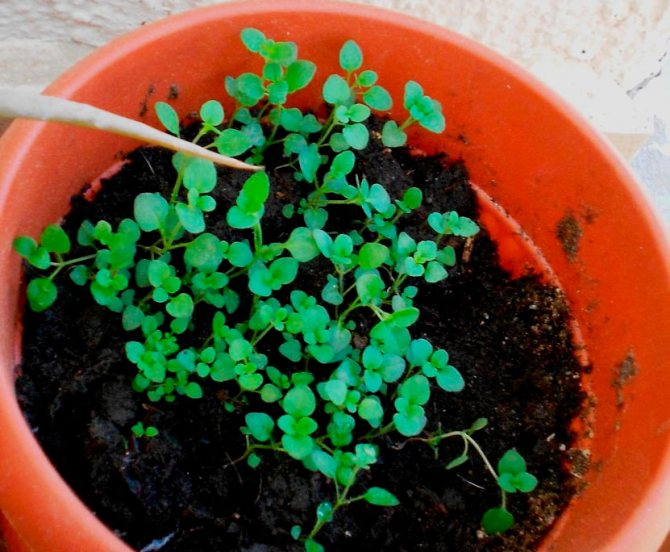

What time to sow for seedlings
Sowing thyme seeds for seedlings is carried out in mid-March. Since the seeds are very small, it is recommended to combine them with river sand in a ratio of 1: 3 before sowing. The container is filled with soil mixture for cacti, and a third of the black soil must be added to it. After that, seeds are evenly distributed on its surface. For sowing, you can also use a substrate consisting of peat and sand (1: 1), while it must be disinfected. It is not necessary to bury the seed in the soil mixture, it is only covered with a thin layer of sand from above. Then the crops are carefully watered from a finely dispersed sprayer, and the container is covered with glass on top and removed to a well-lit and warm place.
Seedling growing rules
Seedlings must be grown indoors for at least 8 weeks.It is best to plant the plants in open soil at the age of 70 days. After the seedlings appear, they are placed in a cooler place, and the glass is removed. Watering is carried out with a sprayer immediately after the top layer of the substrate dries out a little. The room where the seedlings are located should be well ventilated, but they must be protected from drafts.
Growing on a windowsill


Thyme can be grown indoors. To do this, you need a pot that is no more than 15 centimeters across; at its bottom you need to make a drainage layer, the thickness of which should be from 20 to 30 mm. Drainage from above can be covered with a layer of soil mixture (see above for composition). The soil mixture must be moistened, and several seeds must be evenly distributed over its surface, and the top must be covered with a half centimeter layer of substrate, which is then moistened with a spray bottle. The container is covered with a film or glass, then it is removed to a south-facing window, while the crops are protected from direct sunlight. The seed is characterized by good germination. After the seedlings appear, the shelter must be removed. Watering should be moderate, it is carried out after the top layer of the substrate has dried. After 8 weeks, all weak seedlings should be removed, only the most developed should remain. To get fragrant and fresh greens as long as possible, you should cut them often enough, while trying to prevent the bushes from blooming.
Beneficial features
Thyme is used not only in folk medicine, but also in pharmaceuticals for the preparation of medicines. It is used to treat diseases and as a means of strengthening the immune system.
It is considered an effective medicine for bronchial diseases. For the treatment of a prolonged cough, a decoction or infusion is prepared from the herb.
It is prescribed for problems with the gastrointestinal tract (heartburn, gastritis, indigestion, diarrhea, flatulence), for gynecological diseases.
A decoction of thyme helps with toothache
The plant juices contain bactericidal substances, so decoctions help with stomatitis or toothache.
Compresses and lotions with thyme infusion are effective for bruises, rheumatism.
In cosmetology, thyme is used to combat acne and dandruff.
On a note. Essential oils have soothing properties, so aromatic thyme tea helps with headaches and depression. If you spread grass in an apartment or make a cloth bag with thyme, then harmful microorganisms and air pollutants will disappear, the house will have a pleasant smell of fragrant grass. Essential oils repel moths.
Thyme harvested in the field or grown in the garden is equally beneficial for human health. Growing medicinal herbs at home will not cause trouble for the gardener. Its beautiful decorative appearance will decorate the garden, filling it with the spicy scent of meadows.
Summer is the period of harvesting medicinal plants. In June-July, thyme blooms in the thickets of field grass. The smell of a useful shrub spreads for tens of meters around. What thyme looks like, where it grows, how to get the most out of the raw materials, how to distinguish it from oregano - you need to know before collecting the medicinal herb.
Thyme: photos and descriptions of popular varieties
As of 2012, 214 species of thyme have been described and classified. Here are the most popular varieties in horticulture and commercial cultivation (you can read below how different varieties of thyme bloom).
Thyme ordinary
Thymus vulgaris, also known as common or garden thyme, has striking purple flowers and quickly covers all available land, turning into a spreading carpet. Ideal for filling gaps in rock gardens and gaps between stones on the lawn. The leaves of the plant have a strong aroma and can be used for cooking, seasoning for meat and fish.


White creeping thyme
Thymus albus has pale green leaves and an abundance of white flowers that appear in early July. A low herbaceous plant spreads well on the ground and is capable of covering large areas in the shortest possible time. It is a great way to get rid of weeds on your backyard lawn.


Silver thyme
The silver thyme has a special green, more pale silver variegated foliage, it grows in a small bush. Most often used as an ornamental variety for the formation of rock gardenswhere it contrasts with dark green plants.
Pink thyme "Bressingham"
Thyme "Bressingham Pink" is one of the most common varieties in the world. Beautiful, abundant pale green foliage, completely covered with delicate pink flowers in July. The plant attracts pollinating insects well, therefore it is often planted near apiaries as a source of pollen for bees.
Red creeping thyme
Thymus coccineus, or red creeping thyme, is also one of the most common varieties on all continents. The flowers are purple in color on top of tough, creeping, dark green foliage. Great for use as lawn grass or as an ornamental plant along paving stonesas well as among stone slabs. Photos of red thyme in nature are presented below.
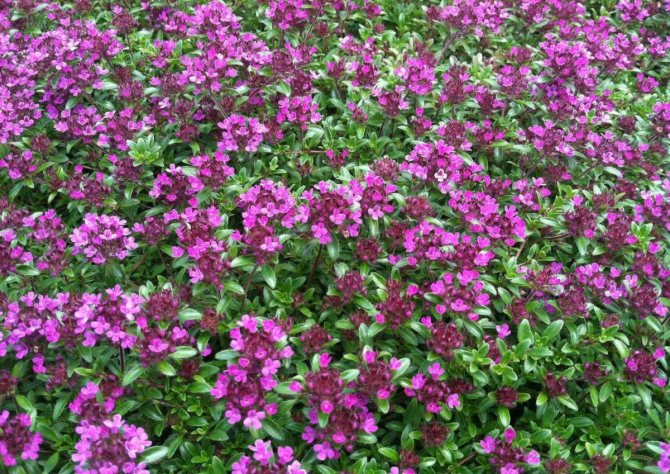

Dawn Valley thyme
The Valley Dawn thyme foliage has a very unusual color that ranges from dark green to bright gold. The tops of the stems are crowned with pale pink flowers that bloom towards the end of summer. Most often grown as decorative flowers in pots or containers. Beautiful pale pink flowers attract insects well, as they have a large amount of nectar.
Thyme "Elf"
Thymus serpyllum "Elfin" is a fairly popular compact dwarf cultivar. A large number of pale lilac flowers are a source of nectar for bees. But there is one peculiarity - insects literally "destroy" all flowers. Photos of thyme are presented below.
Thyme "Archer's Gold"
Thymus citriodorus "Archers Gold" is a low-growing thyme that forms a single herb. Its yellow-green leaves are very reminiscent of lemon in smell. One of the more popular varieties grown commercially for condiments.
Thyme "Variegata"
Thymus citriodorus "Variegata" is another "lemon" variety, the leaves of which, after drying and processing, are widely used as a flavoring or seasoning. The light green foliage contrasts perfectly with the beautiful pink flowers.


Thyme "Peter Davis"
Thymus nitidus "Peter Davis" is a low, creeping thyme with fragrant gray-green leaves and pink flowers that appear in late spring. Prefers open, sunny areas and moderate watering. You can see what the Peter Davis thyme looks like in the photo.


Thyme "Caborn Wine & Roses"
Thymus "Caborn Wine & Roses" is a relatively new variety that was developed in the UK in the early 2000s. Creeping, curly, low-growing litter, the branches of which can reach a length of 40 cm. The leaves are unusually large (in comparison with other varieties of thyme), the flowers are of a delicate pink hue.
Thyme "Bertram Anderson"
Thymus pulegioides "Bertram Anderson" is a very attractive thyme variety that forms neat, spreading mounds of golden leaves. A good choice for forming the edging of flower beds or garden paths. Leaves, even raw, can be eaten as a salad.
Thyme "Silver Queen"
"Silver Queen" refers to dwarf varieties, as it is a fairly compact bush, most often grown at home. Dark green variegated leaves are held on dark crimson stems. In summer, the twigs are covered in clusters of tiny pink flowers.


Crimean thyme
The Crimean variety is a semi-shrub that does not exceed 15 cm in height and spreads well along the ground. Bright pink inflorescences almost completely cover the entire stem. The leaves are oblong, spear-shaped.
What does thyme look like?
Bogorodskaya grass, boron pepper, motherboard are the folk names of the plant. Creeping thyme is the official name for thyme, photos and descriptions of the plant will allow you to recognize it and not confuse it with other herbs. Thyme is a semi-shrub, no more than 35 cm high. The stem is hard, woody, covered with brown bark, spreads along the surface of the earth. It often takes root in places where shrubs grow. The leaves are small, opposite each other, attached with a short petiole. The leaves are oblong. On their outer edge are thin white cilia.
The flowers are small, usually pink or pinkish-purple in color. They are collected in loose cone-like inflorescences. After flowering, a dry fruit is formed, which disintegrates into 4 ball-like nuts.
How to grow thyme.
You can grow creeping thyme by dividing the bushes in spring, using cuttings or seeds. The first two methods are suitable for lovers of varietal crops - "I want it or like from a neighbor", I advise them to buy cultivated decorative varieties of thyme in the nursery. For everyone else, the old grandfather's way of planting creeping thyme, proven for centuries, is suitable - growing with seeds that are easy to collect from the same neighbor.
Just remember thyme seeds ripen unevenly and tend to crumble to the ground, place a newspaper over the plant and shake the thyme plants lightly, dry the crumbled thyme seeds in a warm place, avoiding open sunlight when drying. The germination capacity of the thyme seeds collected in this way lasts three years, and they themselves are very small, 1000 pcs. weighs less than 1 gram.
Thyme planting seeds and care in the open field.
On the street, thyme seeds are planted at a temperature of 12-15 degrees, in spring or autumn at your discretion, in the spring the soil should at least warm up a little, I am guided by the "cry" of the vine.
When planting thyme outdoors I dig the grooves quite deep, on a bayonet and a bayonet and a half of a shovel wide. Then I fill it all with the prepared soil mixture. Actually, I prepare the mixture for planting thyme seeds right in the grooves, below is a complex fertilizer, 40 grams per meter, sand, gravel, humus - about 40% of the groove in depth. All this is thoroughly mixed with a shovel, on top I add a layer of pure black soil another 30%, and spill it well with water. Then humus with black earth in a ratio of 1: 1, I moisten the resulting bed from a watering can, then, planting thyme seeds, lightly press them into the ground and sprinkle them with earth, leveling the soil.
Recently, I began to cover the planting site of thyme seeds with scraps of glass, protecting it from birds (it can be a plastic film, only it must be removed in time so that the thyme seedlings do not get sick with root rot in the resulting greenhouse). The birds do not eat seeds, they are very small, but, digging through the ground, they pull them to the surface and they do not sprout.
After germination, when the seedlings of creeping thyme grow up, and they can be distinguished from the sprouted grass, I thin out, leaving one plant by 20 cm (first three in a bunch, then thin out again).
Care for thyme seedlings no special is needed, only weeding and mulching after watering or rains. You do not need to fertilize thyme in the year of planting, water the next year in the spring with the addition of liquid fertilizer for flowers. If you want a dense lawn, as an alternative to grass lawn, regularly prune the thyme, shortening the stems of the plant by a third. In the fall, be sure to clean the thyme plant of dried or diseased, damaged shoots.
Creeping thyme or thyme. An example of use in landscape design is a photo.
In one place, creeping thyme grows well for 5-10 years, without requiring special care, although there have been cases of growth in abandoned gardens and up to 30 years. Thyme plants are sick mainly with root rot and its varieties, but, as a rule, gardeners themselves are to blame for this by over-watering the plants or choosing the wrong one place for planting thyme.
In our article we will try to describe in detail the planting process and the rules for caring for creeping thyme in simple and understandable language.
You can also see a photo of the plant, learn about the methods of its reproduction, get information about the use and healing properties of the culture for the health of the body.
In the common people, thyme is called thyme, although this is not the only name given to it over time, simply the most common. The plant is also called Bogorodskaya grass.
Varieties of culture, which include about a hundred species, can be found both in Europe, Southeast Asia and in northern Africa.
The benefits of thyme
It is important to harvest the thyme while retaining the maximum benefit. During the flowering period of the shrub, the stems with leaves are carefully cut with scissors, without damaging the roots. Raw materials are laid out in a thin layer in dry ventilated rooms, avoiding direct sunlight. After 5 days, the raw material is crushed, discarding the hard parts.
Pharmacology
Creeping thyme is used in traditional and folk medicine. All useful substances are concentrated in the aerial part of the plant.
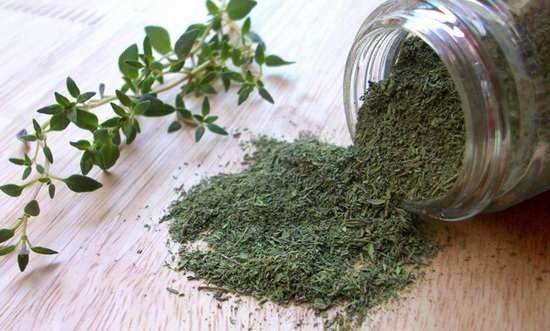

The main chemical elements in the composition of thyme:
- essential oil - thymol;
- tannins;
- gum;
- flavonoids;
- potassium;
- calcium;
- magnesium;
- iron;
- manganese;
- copper;
- sulfur.
Due to the presence of thymol, the plant in the form of infusions is used for diseases of the lungs and bronchi as an expectorant. It is included in many pharmaceutical preparations for the treatment of coughs, inflammatory diseases of the throat and mouth.
More ways to use thyme in treatment can be found in the video.
With the help of decoctions of creeping thyme, alcoholism is treated. Infusion, decoction of the plant in the form of lotions, baths are used for diseases of the joints, skin, nervous system. It is forbidden to take preparations with thyme during pregnancy, liver disease, kidney disease, stomach ulcer during an exacerbation.
Cooking
The tops of the plant with flowers are used as a spice and added to the preparation of meat and fish dishes. Creeping thyme is used in the production of sausages, smoked meats, pates. It is added in the manufacture of sauces, marinades.
Thyme properties: harm and benefit
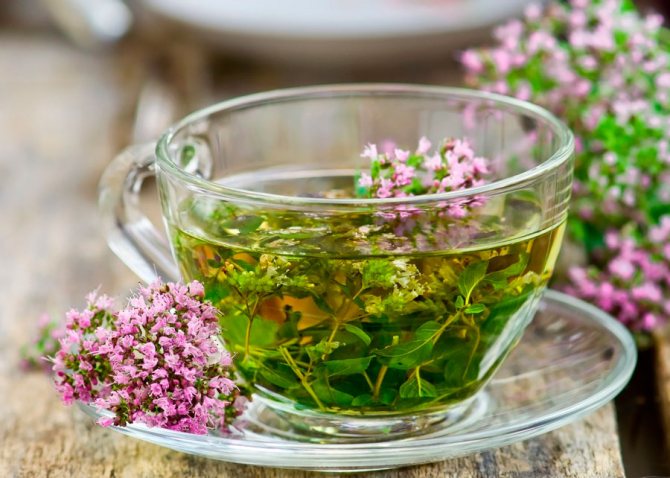

The healing properties of thyme
The aerial part of thyme has healing properties. It is used to prepare infusions and decoctions with antimicrobial, enveloping and expectorant effect, they are used to treat whooping cough, tracheitis, sinusitis, bronchitis, tonsillitis, sinusitis, bronchopneumonia. Such funds help to liquefy sputum and stimulate the activity of the bronchial glands.
Preparations made on the basis of thyme are recommended for use in neuroses, neuralgia, diseases of the gastrointestinal tract (enterocolitis, dysbiosis, dyskinesia, atony, intestinal spasms and flatulence). This culture has also shown high efficiency in the fight against pathogenic microflora, which is insensitive to antibiotics. If you use a pillow filled with thyme for sleep, then headaches and insomnia will no longer bother you. The composition of such a herb includes bitterness, gum, essential oil, tannins, organic pigments and minerals. Essential oils "white thyme" (fresh) and "red thyme" (aged) have a warming effect on the skin, they are used for cosmetic and medicinal purposes. But when using such funds, you must strictly adhere to the instructions and dosages. And it is best to consult a qualified professional.
Contraindications
Since the herb contains a large amount of thymol, it cannot be used for heart and kidney failure, stomach and duodenal ulcers, especially in the stage of exacerbation of the disease. During pregnancy, this herb is also contraindicated, because it can cause the uterus to contract. With prolonged use of thyme preparations or with an overdose, the likelihood of developing hyperthyroidism (Graves' disease) is high. These drugs should not be used to treat children under the age of two.
Growing places
The homeland of the plant is Spain and the south of France. But it is distributed all over the world: in Scandinavia, Europe, Asia, North Africa, North America.
Thyme creeping grows on dry sandy soils, in pine forests, fields. In Russia, it is found in forest, steppe, forest-steppe zones. It is actively harvested in Altai, Stavropol Territory, Rostov Region, Krasnodar Territory, as well as in Ukraine and Belarus. A photo of thyme in nature shows how it looks in forests, fields, steppes.
Thyme creeping planting and caring for a photo.
Morphologically, creeping thyme is a good neighbor for other flowers, it beautifully fills the empty space between the compositions in the flower bed, attracts bees, by the way, flies do not like thyme, for which it received another apt name - the fly-fang.
Thyme meadow - Altai, photo
Creeping thyme is not afraid of frost, drought-resistant, occurs in the wild in pine forests on the edges and sandy slopes, in the steppe and even in the mountains. It blooms from early June to late September with small lilac or purple flowers. In the photo below is thyme in the Altai mountains.
Blooming thyme in the Altai mountains - photo.
For gardeners who decide plant creeping thyme on plots you need to know that he does not like moisture and areas with stagnant water, excess moisture leads to rotting of the roots and the death of the plant. When using thyme in group plantings with other plants, take care of good drainage, you can make it from fine gravel with sand, sprinkling around the plant, and be sure to add this mixture to the planting hole. Do not be afraid, this will not damage the growth of the plant.
Thyme plant photos
Watering thyme creeping should be done in moderation and only during drought periods or before flowering, watering with liquid fertilizer, you will achieve a more lush and long flowering. In practice, thyme requires almost no maintenance, except for pruning, it tolerates drought and lack of fertilization well.
Plant picture
It is difficult to recognize thyme without seeing it before. Often inexperienced herbalists confuse it with oregano. Plants are similar, but they are distinguished by some characteristics.


Distinctive features:
- Plant height. In height, oregano can grow up to 90 cm, thyme - no higher than 35 cm.
- Stem type. In thyme, it spreads along the ground, in oregano, it is erect.
- Leaf shape. In thyme, they are elliptical, in oregano, they are more pointed.
- Flowering time. Earlier, creeping thyme fades - from June to July, oregano - from July to August.
Care
The soil
Plant thyme in well-drained soil with an optimum pH of 6.0 to 8.0. For some varieties, acidity will be fundamental and the pH will be from 6.9 to 7.5 (carefully read the package with seeds). Use hydrated lime to reduce acidity.


Lighting
Thyme needs a lot of sunlight, so when planting, select open areas in advance. Indoors, thyme pots should only be placed on the south or east side. The plant has great drought tolerance, so don't be afraid it will dry out.
Temperature
The optimum temperature for fruitful growth and flowering is considered to be + 20-25 degrees Celsius. The plant does not tolerate frost and a sharp drop in temperature.
Watering
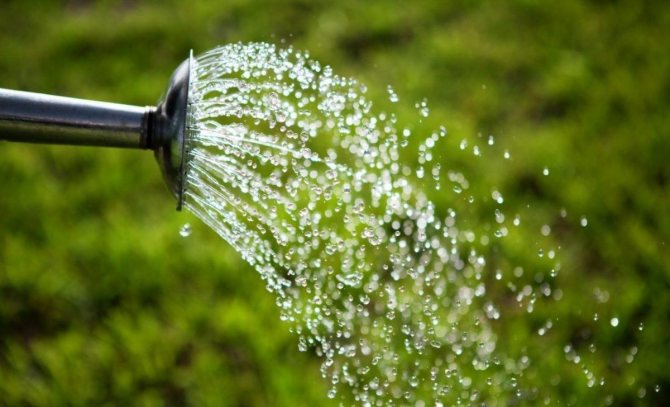

In the summer, watering is carried out once every 10 days. In autumn, watering is stopped, the plant receives moisture only from atmospheric precipitation.Almost all thyme varieties are very drought tolerant and can go without water for 1 to 3 months if necessary.
Fertilizers
Feed your plants every spring with all-purpose dry mineral fertilizers. If thyme stems grow in size too quickly, completely eliminate nitrogen from the top dressing. In the fall, a small amount of organic matter is introduced into the soil in the form of fresh manure.
Similar articles:
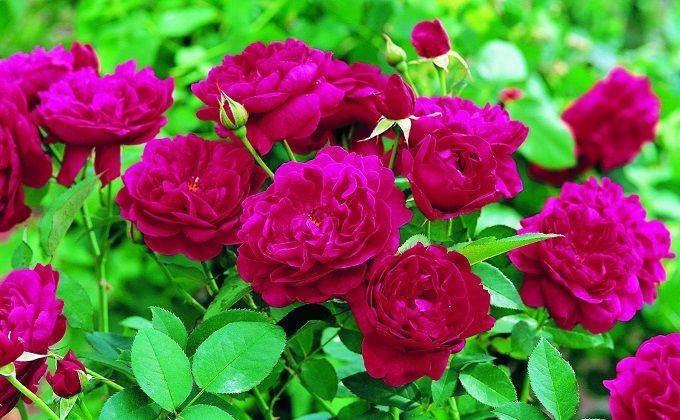

Garden roses - planting, care and reproduction


Broken heart - species, reproduction, planting and care


Periwinkle - species, varieties, reproduction, planting and care ...
Pruning thyme
Cut off at least a third of the height so that the bush is compact. Pruning also prevents self-seeding, stimulates branching, and has a beneficial effect on flowering. The creeping thyme is cut in late autumn, since after the end of flowering, the heads of the inflorescences retain their decorative effect for a long time.
Thyme feels dry for a while after pruning. However, after about 2 weeks, new leaves appear on it.
Early thyme, false pubescent, dwarf, Doflera and other undersized varieties and forms of thyme are not pruned.
Flowers are pruned according to the same rules as trees and shrubs. An oblique cut is made with a sharpened pruner or a garden knife, located at a distance of about 0.5 cm from the last bud, which is left on the plant.
Harvesting.
The plant blooms in May-June, bears fruit in July-August. The crop is harvested at the beginning of the period of mass flowering, starting from the 2nd year of the plant's life. The first cut (10-15 cm from the soil surface) of the aboveground mass is carried out in June, the second - in September-October. When harvesting, raw materials are dried in a dryer, in a well-ventilated room or in the shade under a canopy.
Garden advice! Thyme seeds are harvested from 2nd and 3rd year plants. Thyme can be grown in the same place for 3-5 years. In winter, planting thyme is mulched with peat or fallen leaves.
Growing thyme from seeds: care and suitable conditions
Thyme is a plant that is quite popular among gardeners who specialize in creating rocky gardens. Bushy thyme is usually planted in small groups among stones, creeping species - along the edge of terraces, on top of large boulders and between stone slabs of garden paths.
Choosing the right conditions for growing thyme, you need to know that this plant prefers a sunny or slightly shaded place with light, well-drained soil, preferably sandy.
It is grown on light fertile soils, and preferably through seedlings. Areas with high standing with heavy clay soil are completely unsuitable for them, plants suffer from prolonged stagnant moisture. The best precursors for thyme in the garden are cabbage, potatoes, cucumbers and onions.
The plant tolerates drought easily and prefers slightly moderate watering.
Thyme does not tolerate severe frosts.
Caring for thyme consists in thorough cleaning of weeds, loosening the soil in the aisles and fertilizing with mineral fertilizers. For seed purposes, thyme is harvested from the second year of the growing season. The crop is harvested in the phase of mass flowering, starting from the second year of life, in dry weather.
The first cut of the aboveground mass is carried out in June, the second in September - October.
You can plant thyme for cultivation from seeds at any time - the plants are unpretentious and drought-resistant, but not in late autumn, since the plants should root well before frost. There is no need to fertilize the plants; at best, you can add a little ripe compost or horn flour to the soil. If the thyme bushes are pruned regularly, they will be dense and compact. This is done in early spring or after flowering. The shoots are shortened by about two-thirds - to the lignified part.
Creeping thyme: pests
Thyme withstands the attacks of pathogenic bacteria and pests quite persistently. The main enemies of thyme are:
- weevil;
- aphid;
- meadow moth;
- sandy linger.
Such pests can be overcome by applying fertilizers containing lime and alkaline compounds. In addition, loosening the root portion of the soil and weeding regularly can help.
It is worth noting that creeping thyme can be affected by fungal-type diseases. This happens due to a violation of the cultivation instructions. Namely:
- due to excessive watering;
- with rare weeding;
- due to shading of thyme by other plants.
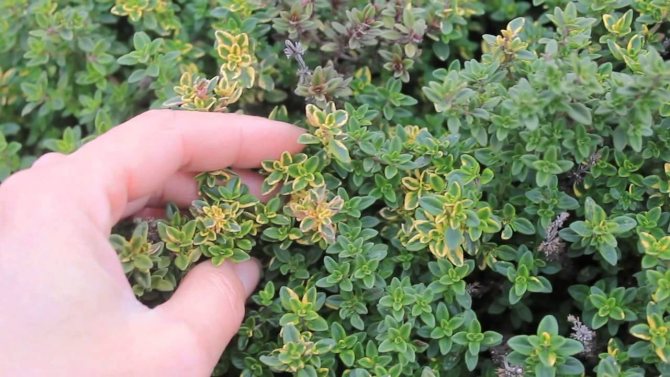

Planting thyme
The choice of planting material
You can plant thyme with seeds, cuttings, seedlings. Therefore, you should initially determine the method of planting.
The easiest and most effective way is to plant the thyme as a seedling. Creeping thyme is not such a rare plant, its seedlings can be bought without much difficulty in specialized stores or the market.
Regardless of which planting method you choose, decide which variety of thyme you would like to plant. Tall varieties are well suited for decorating flower beds and alpine slides, and undersized varieties are used as border plants.
When buying a seedling, be sure to pay attention to its condition. It should not have any damage, dry branches. The roots should be healthy and firm to the touch.
Choosing a place for planting thyme
First of all, the place where the thyme will grow must be very well lit by the sun. It is desirable that it be illuminated throughout the day. With a lack of sunlight and location in the shade, it is difficult to achieve bright colors and lush flowering of thyme.
However, try to keep the area protected from strong winds and drafts.
When planting thyme, give preference to elevated areas. In lowlands on waterlogged soil, thyme will grow very poorly, or even not at all.
Thyme soil requirements and preparation
Thyme prefers less fertile soil. Loamy and sandy loamy soils with a neutral acid-base reaction are perfect.
It is better to start preparing the soil for planting thyme in the fall.
For this, the site is cleared of weeds, carefully dug up. If the samples show that the soil is acidic, then add lime, chalk or dolomite flour to it.
If the soil is completely poor, then apply some organic or mineral fertilizers.
Just before planting, loosen the soil again, break up large clods of earth. The land where the thyme will be planted should be light, loose.
How to plant thyme
- If you plant thyme with seeds, then this is done only after the ground is well warmed up. For most regions, this time falls in mid to late May.
- After sowing thyme seeds, it is highly desirable to cover the crops with foil or agrofibre. In this case, seedlings will appear earlier and more amicable.
- When planting thyme with seedlings, prepare the planting holes according to the size of the root system. Keep the distance between them at least 30 centimeters.
- As mentioned, thyme does not like stagnant water. Therefore, in the planting holes, create a drainage layer of coarse sand, granulation, and small pebbles.
- After all the operations carried out, you can place thyme seedlings in the pits, sprinkle with earth, and lightly compact it with your hands.
- After planting, sprinkle a layer of mulch around each thyme bush and water liberally.
Sowing thyme seeds, growing and caring for them
Thyme (thyme) is a perennial shrub that has a pleasant aroma and contains a large amount of essential oils. He is unpretentious and hardy. It is used as an ornamental plant, and is also used in medicine, perfumery and cooking.
Features of the
Thyme bushes reach a height of 40 cm. Its stems with small leaves grow on the ground. The plant blooms in June-July with small inflorescences and bears fruit in August-September with small nuts (Figure 1).


Figure 1. Appearance of thyme (thyme)
I advise you a new natural remedy to combat joint pain - it regenerates cartilage and joint tissue. Want to try?
It has a strong insect-attracting aroma and a pungent, highly spicy taste. The plant loves sandy soil and space.
Thyme prefers neutral or slightly alkaline soils, resistant to changes in weather conditions. It can also grow on the windowsill, so it will not be difficult to grow thyme in the country.
Landing dates
You can grow thyme from seeds in both spring and autumn. If you decide to sow it in the spring, then choose a warm, not too humid day for this.
Since thyme grows slowly, it can also be grown in seedlings. In this case, sowing begins in the second half of March. In summer, the plant can be propagated by green cuttings, and in autumn - by dividing an already mature bush.
Care rules
There are simple rules that you can follow to grow thyme from seeds in your home garden (Figure 2):
- Choose a bright and well-warmed area by the sun;
- In the fall, dig up and fertilize the soil with rotted manure or compost;
- In the spring, once again dig up the area immediately before sowing with the introduction of urea;
- Sow seeds on the soil surface and sprinkle them with river sand;
- Cover crops with foil;
- Weed regularly and shallowly loosen the ground;
- Watering, avoiding stagnant water.


Figure 2. Proper care of the plant at home
All these manipulations will allow you to get a bountiful harvest of a fragrant culture, which will be an excellent addition to your favorite dishes.
Reproduction of a plant occurs through planting seeds or by dividing an adult bush. Consider the features of sowing the most common species in open ground.
Growing creeping thyme from seeds at home begins in early spring, as soon as it becomes possible to loosen the soil. It must be prepared in advance for spring work: dug up with the introduction of organic fertilizers and free from weeds (Figure 4).


Figure 4. Technology for growing in the open field
The seeds are placed in the soil to a depth of no more than 5 mm and sprinkled with river sand. Seedlings appear after 25 days. Young growth must be thinned out. Next, you need to closely monitor the appearance of weeds and destroy them so that the thyme sprouts can fully develop.
Since thyme is a light-loving plant, its seeds also prefer a sufficient amount of light and heat. Therefore, they need to be sown shallowly, lightly sprinkling with earth. Seed germination begins at an ambient temperature exceeding 20 degrees.
Seedlings emerge very slowly, therefore it is necessary to take care of good air access to the root system, as well as remove emerging weeds in time so that they do not obscure the seedlings. Watering is another prerequisite for growing. It is important not to overdo it. After all, too high soil moisture contributes to root rot.
Of all the breeding methods for thyme, planting with seeds is the most successful. Thyme has a lot of seeds, and as a result, more plants are obtained than when dividing or cutting. It is important to correctly determine the place for sowing, prepare the site and take care of the seedlings.


Thyme varieties with pink and purple flowers


thyme seeds
- Choosing a landing site. Thyme grows in an open and well-lit area. It is not planted in paths between trees or in other shaded areas. A front garden or alpine slide is suitable for growing.
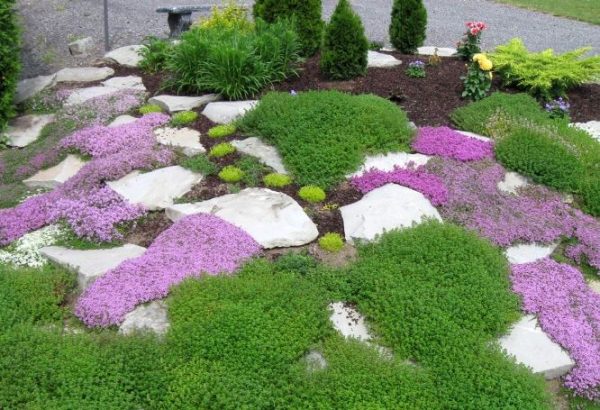

Thyme is grown in an open area
- Soil preparation. The soil for planting must be porous. Seeds are sown in early spring or late autumn. If you plan to plant in early spring, then in the fall the site is dug up to loosen the soil. Then the roots are removed from the weeds. Compost or mineral phosphorus-potassium fertilizers are added to the soil.Before planting, the soil should not be fertilized with manure; it is not needed for thyme. In the spring, the soil is loosened again and urea is added. Seeds are sown one day after fertilizing the soil.
- Sowing seeds in the ground. For sowing, you need to choose days when the weather has already set without frost. It needs a warm and not rainy time.
- Waiting for sprouts to appear within two weeks. Thyme seeds germinate well, so there may be too many plants. Then weak plants are removed from the rows in order to enable the strong to fully develop.
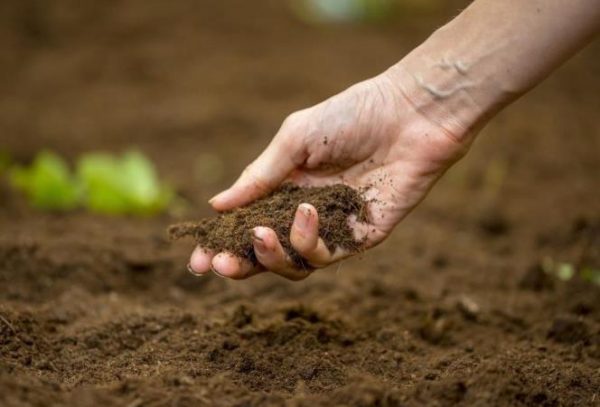

The soil for thyme must be soft
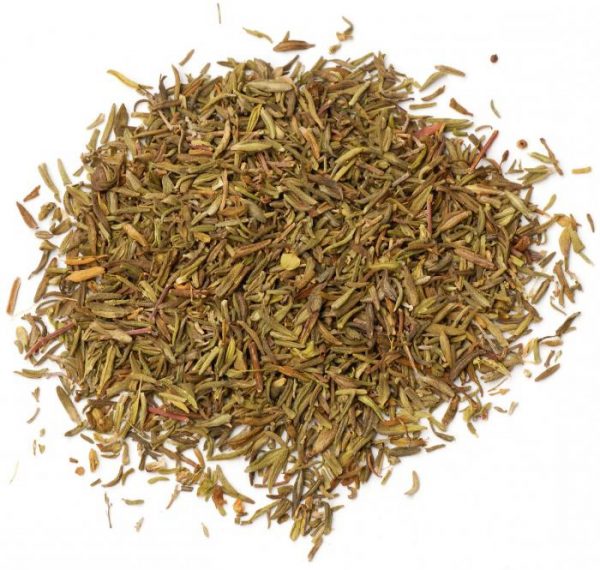

Thyme seeds
When sowing in rows, a distance of at least 30 cm is made between them. Thyme grows and needs space. Experienced gardeners recommend sprinkling the crops with river sand. The minerals contained in it will enrich the soil with nutrients. For germination, a greenhouse effect is required, so the bed is covered with a film.
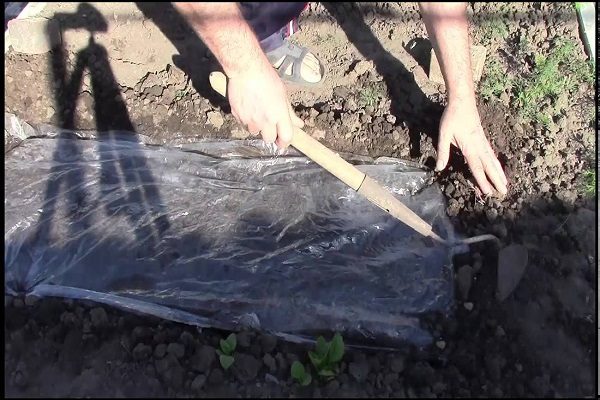

The sowing is covered with a film to create a greenhouse effect.
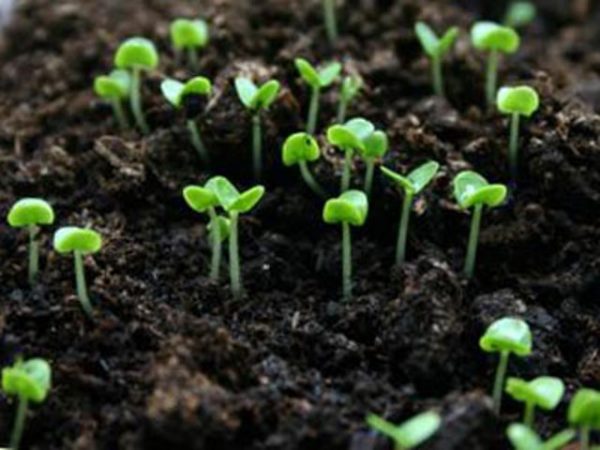

Thyme seedlings in the open field
Growing seedlings
Thyme can be grown as seedlings and then planted in the ground. In this case, sowing takes place in mid-March. Seeds are planted in a tray in which the prepared soil is located. Cover the tray with plastic wrap. Plants will be ready for open field planting in two months. They must be strong and healthy. Seedlings are planted, observing the same distances as when sowing seeds.


Fortified seedlings for future seedlings
Growing and care
A plant needs proper care for its normal development and timely flowering. Sick plants die, so it is worth following some rules for growing thyme:
- Remove weeds regularly in and between rows. At the same time, slightly loosen the ground around the bushes.
- Avoid drying out the soil or stagnant water. When the soil becomes acidic, gray rot appears on the stems and the plant dies. Excessive watering should be avoided, most of all thyme moisture is needed during the period of preparation for flowering. So that the water does not stagnate, the earth is mulched with gravel. The plant easily tolerates short-term drought.
- On one site, thyme grows for five years, then it is transplanted.
- In the fall, before the onset of frost, the plants are cut and shaped. Cut off those parts of the stems that are not yet lignified. For the winter, thyme is covered with peat or fallen leaves so that it does not freeze out.
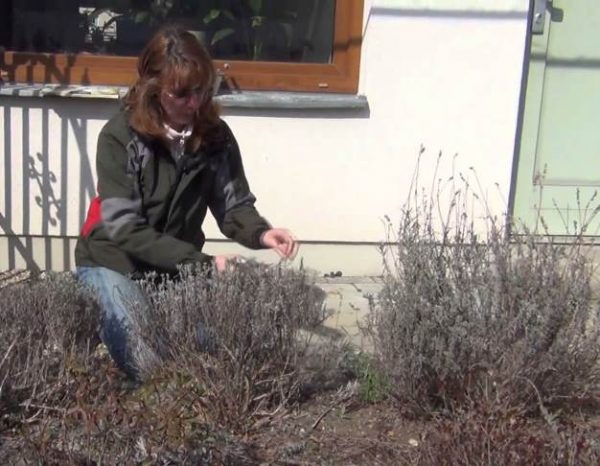

Autumn pruning thyme
- Dried inflorescences are removed after flowering thyme.
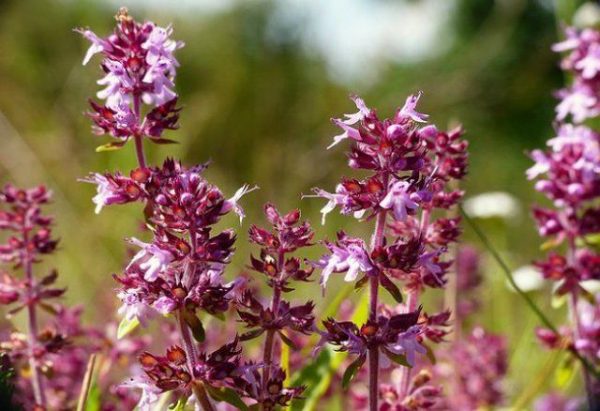

Dried inflorescences must be removed
Diseases and pests
With proper watering and timely weeding, the plant will be healthy. Pests are also rare on thyme because of its pronounced aroma. However, there are cases of the appearance of harmful insects:
Insects damage young shoots, buds and flowers. To combat them, plants are treated with insecticides.
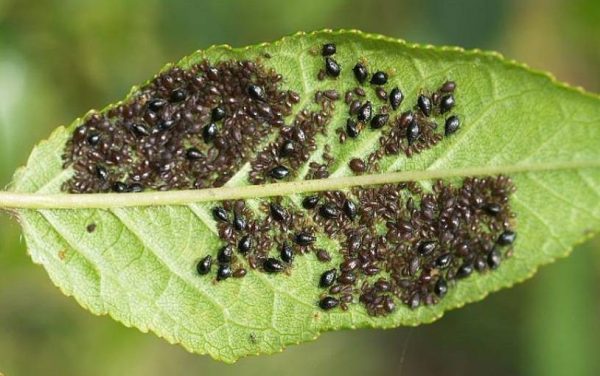

Aphid leaf
Thyme does not like shaded areas, it develops well in the sun. For him, you need to pick up an open place on the site. Many gardeners love to decorate their paths and highlight flower beds. Thyme will perfectly complement the decorative elements of the garden, and the site will look completely different.
We suggest that you familiarize yourself with: How to raise healthy turkey poults? Explanatory advice from the doctor of veterinary medicine
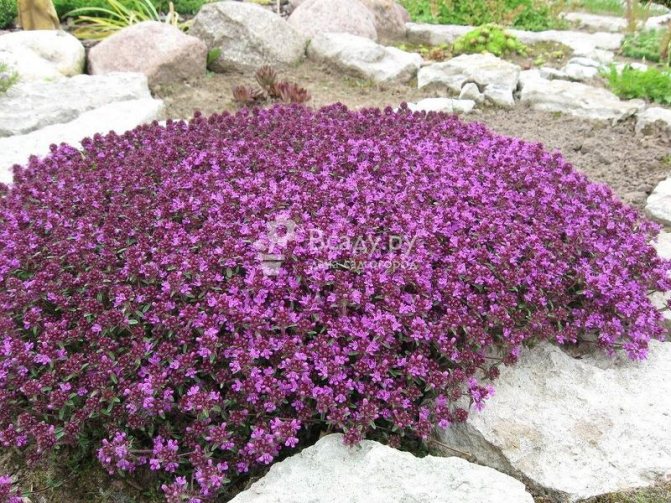

Seed-grown thyme
It is advisable to plant seeds in porous soil with low acidity. To do this, it is best to dig up the area in the fall and remove weed roots from it. The soil is well fertilized with rotted manure or compost, and fertilizers based on phosphorus and potassium are added.
After winter, when the soil becomes soft, and it can already be processed, dig up this place again, making it loose. It is advisable to fertilize it before that using a urea solution (20 grams per liter). After about a day, when the earth is infused, you can start planting.
How to sow thyme?


Warm and not too humid weather favors germination. It is advisable to check the forecast in order to sow when frost is no longer expected. Seeds are sown in rows at a distance of 30-40 cm from each other. This is done so that the shrubs are not cramped when they grow.
Sowing from above should be sprinkled with river sand, since it is saturated with all kinds of minerals and will serve as fertilizer for future plants. Then, the sown bed is covered with a film to create a greenhouse effect.
It will take 2 weeks from the moment of sowing to the appearance of the first shoots. If the seedlings come out very dense, this is not scary, you can simply thin out the thyme, leaving the strongest plants, or move them partially to another place.
Thyme grows slowly, so it can also be grown as seedlings with further planting in the ground. If you chose the seedling method, start sowing in the second half of March. The planting procedure is the same: seeds mixed with sand are sown on the surface of a previously prepared soil.
The average period for growing sprouts, from sowing to transplanting into the ground, is at least two months, so that the plants have time to get stronger and are ready for the new environment. Thyme sprouts are planted in the same way as during sowing - in rows at a distance of 30-40 cm from each other.


Thyme is a decoration for any garden or country yard
In one selected place, thyme is grown for about 5 years. Then it is recommended to transplant it to another place or completely replace it with new crops.
You should regularly and carefully clean the growing bushes of thyme from unnecessary weeds. It will also be useful to slightly loosen the soil under the sprouts. When it comes to watering, be very careful. Do not let the earth dry out, but do not overfill, so that it does not acidify. For the winter, shrubs can be covered with leaves or peat if desired, they can easily endure winter time.
The most popular varieties among gardeners
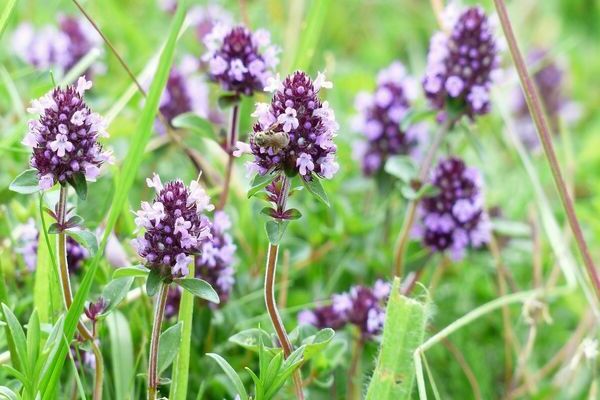

What creeping thyme looks like: close-up photo
- Dorflera is a thermophilic early thyme variety that cannot tolerate cold. It is short and has a fluffy texture. When flowering begins, a thick carpet of small flowers painted in gray and framed by small leaves is formed.
- Siberian - this variety has very powerful, well-developed roots. Many colors dyed with deep pink color allow you to enjoy their beauty all summer months. They reproduce vegetatively.
- Japanese - this variety does not disregard gardeners. He is able to decorate any flower beds with his bright pink flowers and at the same time fill the garden with a pleasant aroma. It blooms for 21 days in the last summer month.
- Creeping - with the help of this variety, you can make a beautiful and dense curtain of green leaves, white and pink flowers.
Brief description of cultivation


- Sowing... Sowing thyme for seedlings is carried out in mid-March. The plant is planted in open soil from mid to late May.
- Bloom... Bushes bloom from June to August. In this case, the first time the bushes bloom in the second year of growth.
- Illumination... The site can be sunny or in partial shade.
- Priming... Nutritious light drained alkaline or neutral.
- Watering... Watering should be done in moderation only when necessary, but when the bushes are blooming, watering should be more frequent. If there is a lot of rain in the summer, then you will not need to water the thyme.
- Fertilizer... It is necessary to feed the bushes only when grown on poor soil, while horny flour should be added to it, and the surface of the garden should be covered with a layer of mulch (rotted compost).
- Pruning... Shortening the stems by 2/3 is carried out at the beginning of the spring period, as well as after the bushes have faded.
- Reproduction... By cuttings, seeds and dividing the bush.
- Harmful insects... Aphids, sandy slugs, meadow moths and weevils.
- Diseases... With increased soil moisture, the bushes are affected by fungal diseases.
What plants can be combined with Thyme creeping in the garden


Creeping thyme: photo in a flowerbed
Green herbs of creeping thyme are a great option for creating a background for many garden plants painted in bright colors. For example, peonies and chrysanthemums, roses and lilies, tulips and daffodils will look great against the background of noble greenery.
When making mixed borders, thyme can be planted as a creeping carpet between plants, or framed flower beds with it. It looks great with conifers, for example, with pine, spruce or thuja, as well as with low-growing varieties of juniper or dwarf pine.
In nature, there are varieties such as Japanese Thyme, Dorflera, Creeping Thyme, Siberian Thyme, Early Thyme. But scientists do not stop and every year they present more and more varieties of creeping thyme. Today there are more than 100 different varieties in the world.
Thyme appearance
Thyme is a flowering perennial shrub with a creeping, creeping or ascending stem. Another name for the plant is thyme. The average height of thyme is 35 cm, the size of the leaves is 0.3 - 0.8 cm. The inflorescences in the form of an ear of lilac, pink, purple or white fragrant flowers have a strong aroma that attracts insects.
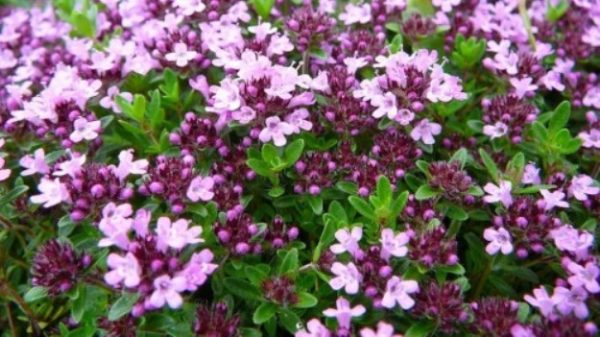

Thyme appearance
Thyme blooms in early May and ends in late summer.
Contraindications and possible harm to spices
When you shouldn't eat thyme:
- with gastritis with high acidity;
- stomach or duodenal ulcer;
- colitis, enterocolitis;
- heart failure;
- children under 12 years old;
- if you are allergic to thyme.
Possible side effects of herbs and flowers are allergic reactions in the form of rash, itching, local redness.
With prolonged or heavy use of thyme in any form, it can cause a semblance of menstruation in women. This will essentially be bleeding, not periods. Thyme herb inhibits the thyroid gland.
Photo of thyme
Features of thyme
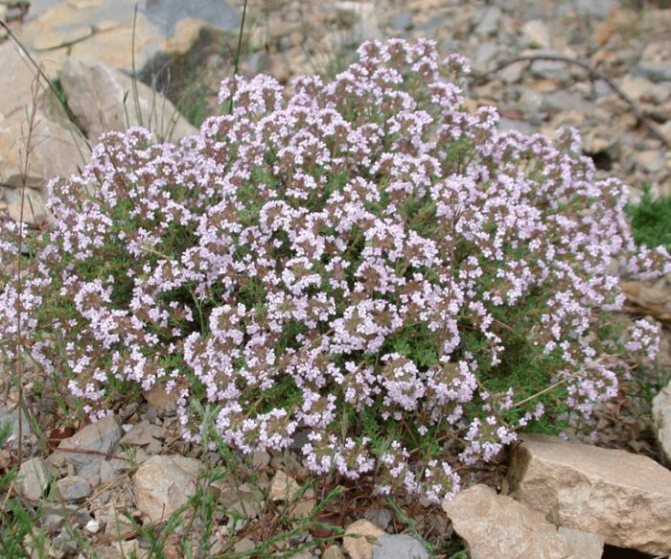

The height of thyme bushes can reach about 0.35 m. Woody stems can be ascending or recumbent, and flowering herbaceous branches are erect or ascending. The woody root is tap root. Depending on the species, the leaf plates of a given plant may differ in size, shape and venation. Most often, they have short petioles, and the plates themselves are rigid and leathery, less often they are whole-edged and sessile, while the leaves of the Far Eastern species are serrated. Elongated or capitate inflorescences are located at the tops of the branches, they consist of flowers of pink, white or purple color. The fruit is a box, which includes 4 spherical nuts with a bitter taste and pleasant smell, they are used as a seasoning called "black thyme". Such a plant grows from June to August. Fruit ripening occurs in August – September. This crop is related to the following plants: lavender, oregano, rosemary, hyssop, basil, motherwort, sage, lemon balm and mint. In recent years, such a plant has become very popular among gardeners; today it is grown in the garden almost as often as celery, dill and parsley.
Reproduction methods
Breeding varietal thyme is possible with:
- seeds;
- cuttings;
- dividing the bush into parts.
Seed reproduction
Thyme can be propagated using seeds, however, this method is not the most successful, all because seeds in open ground do not germinate well. Most often due to lack or excess of moisture, temperature changes, frost, cold soil. But, if there is no choice, then you can try this method. So, the principle of seed propagation of thyme:
- After flowering on the stems of thyme, fruits are formed - boxes with seeds. These seeds are carefully removed from the "house" by pouring them onto a paper sheet.
- They are laid out on paper in a thick layer and left on the windowsill to dry in the sun. When completely dry, they will take on a golden hue.
- The seeds are stored until spring in a paper envelope in a dry, dark place.
- If it is decided to grow the thyme in a seedling way, then the seeds are sown at the end of winter, if soil - in May.
Cuttings
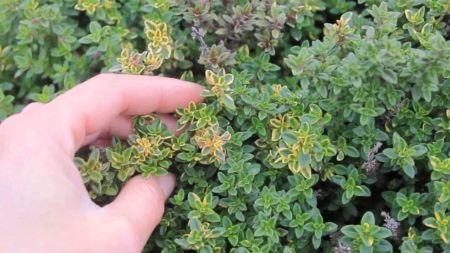

The strongest and healthiest cuttings (in this case, twigs) are selected for cuttings during pruning. They are cut close at the base, where the site is already lignified. Next, cuttings are made:
- the twigs are placed with their lower end in water for 2-3 days, so that the buds swell and open slightly.
- Then the twigs are transplanted into a soil substrate enriched with minerals. Several branches can be planted in one seedling container.
- If the weather permits, then cuttings can be done on the garden bed under the greenhouse. To do this, a small trench is dug and sprigs of thyme are planted there.
- Before planting, all leaves and stepsons are removed from the branches.
- Cuttings are planted in the ground shallow, about 2-3 centimeters below the surface of the earth.
- Cuttings root well in a warm, sunny place. If they grow in a nursery, then the container is placed on the windowsill, if on the street - a greenhouse is made.
- The first roots will appear after a few weeks. It is enough to root the branches only after 5-6 weeks. Only then can the thyme be planted in a permanent place.
Dividing the bush
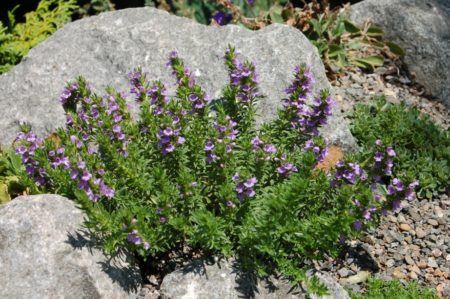

This is a less efficient breeding method. This is due to the fact that the plant tolerates the plot very poorly. However, if other methods are not available, then you can resort to dividing the bush. True, not any plant is suitable for this procedure: adults who have a well-developed root system of the plant take root best of all. It is preferable to divide a three-year-old bush. Reproduction technique:
- A well-rooted bush is completely dug out of the ground.
- The roots are cleaned of soil lumps.
- The bush is divided in half so that each part has a piece of the uterine root.
- Two shallow planting holes are being dug.
- Provide each of them with organic fertilizers.
- The roots are watered with a manganese solution, then soaked in a growth stimulator.
- Each bush is planted strictly vertically, covered with earth.
- From above, the soil is compacted, watered.
Application recipes


Thyme for men
In late summer and early autumn, pink thyme flowers are harvested. 1 tbsp pour 200 ml of raw materials. boiling water, leave for 15-30 minutes. Take 0.5 tbsp. 5-6 times a day for 30 minutes. before meals. The course of treatment is 3-6 months.
This remedy is used for impotence in men caused by excessive alcohol consumption.
Thyme in landscape design
Thyme is good as an ornamental plant on rocky hills and rock gardens, small flower beds in combination with other bright and large flowers. A soft lilac thyme carpet looks great as an element of decorating the borders of summer paths and flower beds, it will serve as an excellent alternative to a grass lawn.
Unpretentious and fragrant, thyme will become an intricate decoration of rockeries and borders. And its indescribable, fragrant aroma will fill a summer summer evening with spicy notes.
Low bushes usually adorn an alpine slide or line garden paths. Summer residents arrange stony placers on the site, which can also be decorated with thyme. A bright plant can be a beautiful backdrop for a photo. The spicy aroma creates a special cozy atmosphere for the patio. You can read about how to make a beautiful garden with your own hands in our article.
Unusually, you can arrange paths or areas lined with large stones. For this, thyme is sown around the stones, filling the entire distance between them with the plant. The owners make sure that the thyme does not grow too much and creates a beautiful pattern.


Stone-paved courtyard decor
Testimonials
Maria
Thyme is known to me primarily for its medicinal properties. This fragrant herb is great for coughing. Therefore, in our house there is always a bag of dry herb, which we brew as soon as one of the family members starts to get sick. Mom said that before, newborns were bathed in water with thyme added. It turned out that many people grow thyme in the garden as a flower crop. Indeed, the plant is not capricious. Does not “take offense” at the lack of water, grows well in the shade. In general, if you want to decorate your garden, then thyme is the best candidate for this.
Elizabeth
We live in the countryside, so the fields around our village are completely covered with thyme. We have different species, but creeping is the most beautiful. It spreads like a carpet on the slopes of the hills, beautifully grows along the banks of the rivers. In the middle of summer, everything around is covered with small purple flowers, which exude a strong herbal scent that is felt even at home. I heard that landscape designers hold this herb in high esteem. It is not surprising, because thyme is such a viable herb that it can tolerate a drought for many days, an invasion of all kinds of pests. And her illness does not concern her at all. In fact, a very good herb, and most importantly, useful.
Combination with other plants
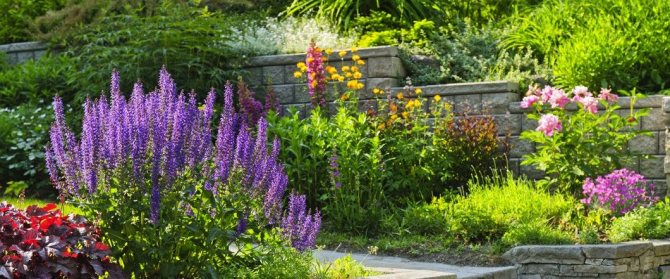

The noble greenery of thyme creates a favorable backdrop for many garden plantings with bright colors. Among them:
- pion;
- chrysanthemums;
- roses;
- lilies;
- tulips;
- daffodils and others.
In a mixborder, thyme is planted between the plants in a creeping carpet or as a framing for a composition. In the rock garden and other stone ensembles, the garden plantation is often "adjacent" to conifers. These can be both large trees (pine, spruce, thuja) and undersized representatives of the culture (undersized juniper varieties, dwarf pine).
The use of thyme herb in cooking
Thyme has been known since ancient times and is bred in many countries of Europe, North America and North Africa for the sake of essential oil, which has a strong antiseptic properties.
The herb thyme is used due to the fact that it contains 0.6% -1.0% of essential oil. The herb also contains tannins and dyes, bitterness, gum, cinchona, coffee, ursuloic, chlorogenic, oleic and oleanolic acids, flavonoids, resins, fats, a large amount of mineral salts, and vitamin C. The plant, imperceptible in appearance, belongs to the category of aphrodisiacs.
The use of thyme in cooking is due to its taste and aroma. Dry added to teas, soups, main courses.
Varieties of varieties
Thyme has a huge variety of varieties. It is simply amazing. Let us dwell on the main and most popular types that will best decorate your garden and will not cause hassle to care for.
Common thyme


Common thyme can be of different sizes and colors, in the photo is white thyme
Does not reach a height of more than 15 cm. It is actively used in medicine. It has small leaves, blooms in white or light purple.
There is an artificially bred hybrid based on common thyme - this is lemon thyme. It has a characteristic lemon scent.
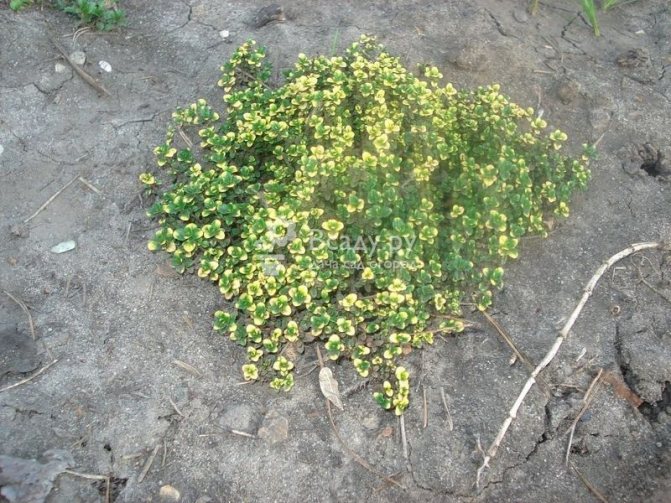

Bogorodsky color or thyme can have not only lemon aroma, but also taste
In winter, planting thyme should be covered. And to maintain the cultural form and density, the bushes need to be pruned.
Dwarf thyme
The height of the thyme is very small - up to 5 cm. This variety grows in dense islands of small diameter. Dwarf subspecies are found in white, scarlet or red.
Creeping Thyme
A perennial shrub with creeping stems. Its flowers are pink, white and crimson. The leaves are rather large and reach 1 cm in length. The flowering period falls at the end of summer.
Thyme Bogorodsky
Thyme will saturate both tea and summer air of Vsadu.Ru
Shrubs grow on one planting for up to 4 years. Their stem is thin and creeping, they are often decorated with fences, walls of houses and gazebos. This variety blooms in lilac-pink color, has a bright aroma and a bitter taste.
Thyme Rainbow
This variety is most often recommended for planting in plots, as it is very beautiful. Young leaves can be eaten and added as a seasoning to various dishes, they are very useful.
Rainbow thyme reaches 25-30 cm in height, and many summer residents plant it along the fence so that it delights them with pink and purple flowers. With proper care, it can grow up to five years.
The species has 300 varieties that grow in Europe, Asia and Africa. On personal plots, only those are grown for which it is possible to create favorable conditions on their own.
Table. Thyme varieties for planting in the country or in the courtyard of a private house.
| Name | The length of the stems and the nature of the vegetation | Flowers | Sheets | Application |
| Thyme ordinary | Bush height 15 cm, semi-shrub with ascending shoots | White or light purple | Small, with villi below | For medical purposes |
| Lemon thyme | Stems 30 cm sprawling or erect, the bush is usually cut to give a rounded appearance | Lilac | Oval, in a young plant - greenish-yellow, in an adult - light green | In cooking, as a lemon-scented seasoning for food and drinks |
| Dwarf thyme | Dense and dense vegetation 5 cm high | White, scarlet or red | Small, 3 - 5 mm | Landscape design |
| Creeping thyme | Curly stems, long | Pink and crimson, late summer blooms | Large, about 1 cm | For medical purposes |
| Rainbow thyme | 20 - 25 cm | Purple or pink | Grayish green | Landscaping, window sill decoration, food and drink seasoning |
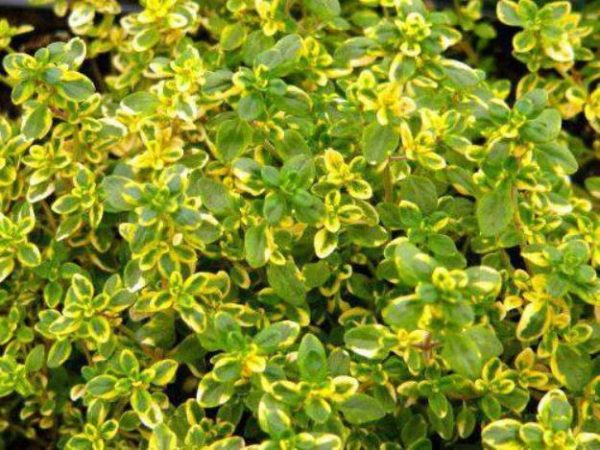

Lemon thyme (lemon-scented or vegetable)
There are many different varieties of thyme, but the most popular are common, creeping and lemon.
Description of varieties
Creeping thyme is a perennial shrub with numerous creeping stems that take root well and grow stiff with age. Small leaves are located on them. In the middle of summer, the plant is covered with flowers of purple, red, pink or lilac shades. Such a plant tolerates a drop in temperature and a lack of moisture well. It is used as an ornamental ground cover plant.
Common thyme is classified as a medicinal plant. It unites various species, among them dwarf ones. The leaves of the common variety are pubescent on the underside, the flowers are lilac in color. They begin to bloom in July, and the flowering process ends in September. Then you can start collecting medicinal raw materials.


Figure 3. The main varieties of thyme: 1 - creeping, 2 - ordinary, 3 - lemon
One of the most beautiful species is called lemon, which is most often used for decorative purposes. It got its name due to its specific citrus aroma. Unlike previous varieties, it is more susceptible to frost. But it perfectly tolerates drought and is not afraid of direct sunlight. The plant blooms with purple flowers in June-July. The main varieties of thyme are shown in Figure 3.
Growing conditions
Growing thyme from seeds is simple as it is a relatively unpretentious crop. However, this does not mean that he does not need care at all.
Since thyme has a shallow root system, the soil beneath it does not need to be deeply loosened. It is much more important to control weeds, as it germinates slowly and its shoots can be drowned out by weeds.
It is also important to establish watering of the plant. The culture needs moisture, but it is very sensitive to its excess not only in the soil, but also in the air.Therefore, water stagnation at the roots should not be allowed, as this causes their decay.
Beneficial features
Traditional medicine has long been familiar with the beneficial properties of thyme. It is used as a sedative and anti-cold remedy, to improve digestion and fight worms.
We suggest that you familiarize yourself with: How to grow elecampane high on your site
In the treatment of diseases of the upper respiratory tract, a decoction of the herb is used, and compresses based on thyme are useful for bruises and pains of various etiologies. Outwardly, it is used for inflammation of the eyelids, for wound healing. Thyme baths have a calming effect and are also indicated for joint pain and problem skin.


